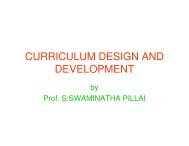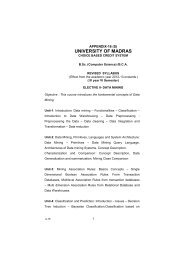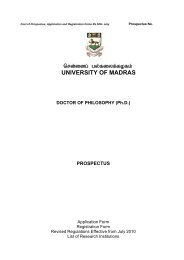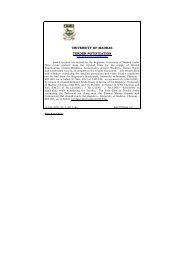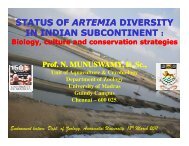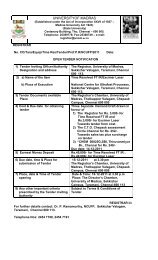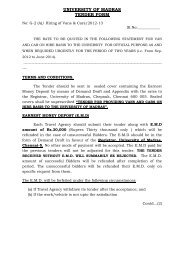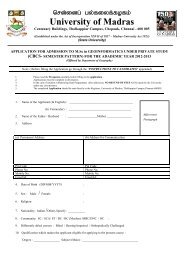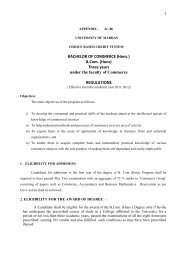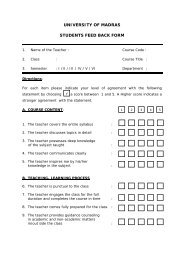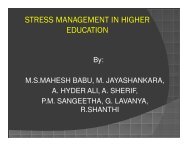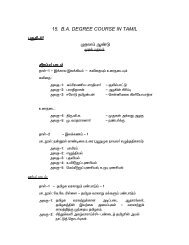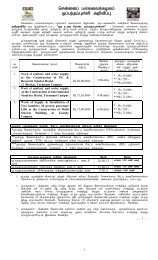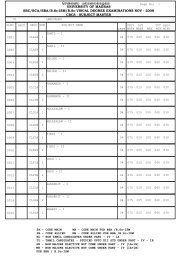Download - University of Madras
Download - University of Madras
Download - University of Madras
You also want an ePaper? Increase the reach of your titles
YUMPU automatically turns print PDFs into web optimized ePapers that Google loves.
APPENDIX - 27 (R)<br />
UNIVERSITY OF MADRAS<br />
M.Sc. DEGREE COURSE IN BIOTECHNOLOGY<br />
Choice Based Credit System<br />
REVISED REGULATIONS<br />
(w.e.f. 2012-2013)<br />
1. CONDITIONS FOR ADMISSION:<br />
A Candidate with a Bachelor’s Degree in Science in the disciplines <strong>of</strong><br />
Biotechnology,, Biology, Botany, Zoology, Microbiology, Genetics,<br />
Chemistry, Biochemistry, Physics, Agriculture from this <strong>University</strong> or B.E/<br />
B.TECH (Biotech), B.V.Sc, MBBS, BDS or an examination <strong>of</strong> some other<br />
<strong>University</strong> accepted by the Syndicate as equivalent thereto shall be for<br />
the M.Sc Degree Examination <strong>of</strong> this <strong>University</strong> after a course <strong>of</strong> two<br />
academic years in an Affiliated Colleges <strong>of</strong> this <strong>University</strong>.<br />
2 DURATION OF THE COURSE:<br />
The duration <strong>of</strong> the course is for two academic years consisting <strong>of</strong> four<br />
semesters.<br />
3. STRUCTURE OF THE COURSE<br />
The course is organized on semester basis with a total <strong>of</strong> four semesters.<br />
In first, second and third semesters, there are three (core ) theory papers<br />
(9 hrs per week), one Core Practical (15hrs per week) and Two elective/<br />
optional papers(4hrs per week), per semester and in the fourth semester,<br />
there are only one core theory papers (Research Methodology) (4hrs<br />
per week), a core project/ dissertation work constituting a total <strong>of</strong> 20<br />
hrs per week, two electives (4hrs per week), and a S<strong>of</strong>t skill program<br />
(2hrs per week).<br />
Elective paper: Each student shall opt for a comprehensive, interactive<br />
course with one <strong>of</strong> the faculty member. The topic <strong>of</strong> specialization and<br />
course content will be determined by the dept/ course advisor.<br />
Core Practical Laboratory: Independent practical shall be held under<br />
each component. It is recommended that the practical training be<br />
1
organized as an exercise rather than simple demonstration. The students<br />
must actually perform the experiments.<br />
4. ELIGIBILITY FOR THE AWARD OF DEGREE:<br />
A candidate shall be eligible for the award <strong>of</strong> the degree only if he/she<br />
has undergone the prescribed course <strong>of</strong> study in a college affiliated to<br />
the <strong>University</strong> for a period <strong>of</strong> not less than two academic years, passed<br />
the examination <strong>of</strong> all the four semesters prescribed earning minimum <strong>of</strong><br />
91 credits and fulfilled such conditions as have been prescribed therefore.<br />
A candidate shall be eligible for the award <strong>of</strong> the degree only if he/she<br />
has undergone the prescribed courses on S<strong>of</strong>t Skills and internship in<br />
addition to the courses prescribed by the respective Board <strong>of</strong> Studies for<br />
the subject <strong>of</strong> the Masters Degree. For two years Master’s Degree<br />
Programme, a candidate shall undergo a minimum <strong>of</strong> 4 courses<br />
(4 x 2=8 credits) from the courses on S<strong>of</strong>t skills.<br />
A two year Master’s Degree student shall undergo 4-6 weeks (2 credits<br />
internship during the summer vacation <strong>of</strong> the First year and submit a<br />
report in the beginning <strong>of</strong> third semester. The report will be evaluated in<br />
third semester and the marks forwarded to the <strong>University</strong> along with third<br />
semester internal assessment (CIA) marks.<br />
5. EXAMINATIONS:<br />
There shall be four semester examinations: first semester examinations at<br />
the middle <strong>of</strong> the first academic year and the second semester examination<br />
at the end <strong>of</strong> the first academic year. Similarly, the third and fourth semester<br />
examinations shall be held at the middle and the end <strong>of</strong> the second<br />
academic year, respectively. Practical examination shall be conducted<br />
independently at the end <strong>of</strong> even semesters. For practical examination, a<br />
single comprehensive) (covering different courses <strong>of</strong>fered during that<br />
semester) practical examination (6hrs per day) be held for each component<br />
<strong>of</strong> the core practical at the end <strong>of</strong> even semesters.<br />
Examinations for the courses on s<strong>of</strong>t skills will be held along with the<br />
semester examinations <strong>of</strong> the core and elective courses. There is no written<br />
examination for internship. A student shall submit a report after completing<br />
2
the summer internship. The report will be evaluated by two examiners<br />
within the Department <strong>of</strong> the college/ institution.<br />
6. COURSE OF STUDY AND SCHEME OF EXAMINATIONS:<br />
FIRST SEMESTER<br />
S .<br />
No.<br />
Course<br />
Components<br />
Name <strong>of</strong> Course<br />
Semester<br />
Inst.<br />
Hours<br />
Credits<br />
Exam Max. Marks<br />
HRS CIA External<br />
1. Core Paper-1 Biochemistry I 3 3 3 25 75<br />
2. Core Paper-2 Molecular Genetics I 3 3 3 25 75<br />
3. Core Paper-3 Molecular Cell Biology I 3 3 3 25 75<br />
4. Core Paper-4<br />
Practical-I<br />
5. Paper-5*<br />
Elective<br />
6. Paper-6 *<br />
Elective<br />
Practical – I<br />
(A)Biochemistry<br />
(B)Molecular Genetics<br />
(C) Molecular Cell biology<br />
I 15 10 6 40 60<br />
Bioinstrumentation I 2 2 3 25 75<br />
Biostatistics I 2 2 3 25 75<br />
7. Paper-7 * Enzymology I 2 2 3 25 75<br />
Elective<br />
8 S<strong>of</strong>t Skill - I I 2 2 3 40 60<br />
Total Credits : 25<br />
*Candidates can opt for any two Electives<br />
(Practical examination shall be conducted independently at the end <strong>of</strong><br />
even semesters.)<br />
SECOND SEMESTER<br />
S.<br />
No.<br />
Course<br />
Components<br />
Name <strong>of</strong> Course<br />
Semester<br />
Inst.<br />
Hours<br />
Credits<br />
Exam<br />
HRS<br />
CIA<br />
Max. Marks<br />
External<br />
9. Core Paper-8 Microbiology II 3 3 3 25 75<br />
10. Core Paper-9 Plant and Animal<br />
II 3 3 3 25 75<br />
Biotechnology<br />
11. Core Paper-10 Genetic Engineering II 3 3 3 25 75<br />
12. Core Paper-11<br />
Practical-II<br />
13. Paper-12*<br />
Elective<br />
Practical - II<br />
(A) Microbiology<br />
(B) Plant and Animal<br />
Biotechnology<br />
(C) Genetic Engineering<br />
II 15 10 6 40 60<br />
Tissue Engineering II 2 2 3 25 75<br />
3
14. Paper-13*<br />
Elective<br />
15. Paper-14*<br />
Elective<br />
Pharmaceutical<br />
Biotechnology<br />
Environmental<br />
Biotechnology<br />
II 2 2 3 25 75<br />
II 2 2 3 25 75<br />
16. S<strong>of</strong>t skill - II II 2 2 3 40 60<br />
*Candidates can opt for any two Electives<br />
THIRD SEMESTER<br />
Total credits: 25<br />
S.<br />
No.<br />
Course<br />
Components<br />
Name <strong>of</strong> Course<br />
Semester<br />
Inst.<br />
Hours<br />
Credits<br />
Exam<br />
HRS<br />
CIA<br />
Max. Marks<br />
External<br />
17 Core Paper-15 Bioinformatics III 3 3 3 25 75<br />
18 Core Paper-16 Immunology III 3 3 3 25 75<br />
19 Core Paper-17 Bioprocess Technology III 3 3 3 25 75<br />
20 Core Paper-18<br />
Practical-III<br />
21 Paper-19 *<br />
Elective<br />
22 Paper-20*<br />
Elective<br />
23 Extra *<br />
disciplinary<br />
elective<br />
Practical - III<br />
(A) Bioinformatics<br />
(B) Immunology<br />
(C) Bioprocess Technology<br />
III 15 10 6 40 60<br />
Nano Biotechnology III 2 2 3 25 75<br />
Molecular Developmental<br />
Biology<br />
Any Elective <strong>of</strong>fered by other<br />
Depts.<br />
III 2 2 3 25 75<br />
III 2 3 3 25 75<br />
24 S<strong>of</strong>t skill - III III 2 2 3 40 60<br />
25 **Internship Internship in Industries or<br />
Research Laboratories<br />
related to Biotechnology<br />
III - 2 - - 100<br />
Field<br />
26 Elective <strong>of</strong>fered<br />
to other Dept.<br />
Principles <strong>of</strong> Gene<br />
Manipulation Technology<br />
III 2 3 3 25 75<br />
Total credits: 28<br />
(Practical examination shall be conducted independently at the end <strong>of</strong><br />
even semesters.)<br />
*Candidates can opt for any one Elective and one Extra disciplinary<br />
elective<br />
** Internship will be carried out during the summer vacation <strong>of</strong> II Semester<br />
and the report will be evaluated by two examiners within the Department<br />
<strong>of</strong> the college/ institution. The marks should be sent to the <strong>University</strong> by<br />
the College and the same will be included in the Third Semester Marks<br />
Statement.<br />
4
FOURTH SEMESTER<br />
Max. Marks<br />
S.<br />
No.<br />
Course<br />
Components<br />
Name <strong>of</strong><br />
Course<br />
Semester<br />
Inst.<br />
Hours<br />
Credits<br />
Exam<br />
HRS CIA External<br />
27 Core Paper-21 Research<br />
Methodology<br />
28 Paper-22* Stem Cell<br />
Elective Biology<br />
29 Paper-23*<br />
Elective<br />
Bioethics,<br />
Human<br />
Rights and<br />
Social Issues<br />
IV 4 3 3 25 75<br />
IV 2 2 3 25 75<br />
IV 2 2 3 25 75<br />
30 Core Paper-24 Dissertation IV 20 15 60 240<br />
(40-work<br />
book, 150<br />
Dissertation<br />
+ 50- Viva)<br />
31 S<strong>of</strong>t skill - IV IV 2 2 3 40 60<br />
Total credits: 22 / 24 *<br />
*Candidates can opt for any one <strong>of</strong> the two Electives and the additional<br />
2 hours shall be used for Dissertation work. However, additional<br />
elective paper can be opted for earning extra credits.<br />
The following procedure be followed for Internal Marks:<br />
Theory Papers: Internal Marks : 25<br />
Best Two tests out <strong>of</strong> 3 10 marks<br />
Attendance<br />
5 marks<br />
Seminar<br />
5 marks<br />
Assignment<br />
5 marks<br />
25 marks<br />
Practical: Internal Marks: 40<br />
Attendance<br />
- 5 marks<br />
Practical Best Test 2 out <strong>of</strong> 3 - 25 marks<br />
Record<br />
- 5 marks<br />
Viva<br />
- 5 marks<br />
5
Break-up Details for Attendance<br />
Below 60%<br />
- No marks<br />
60% to 75% - 3 marks<br />
76% to 90% - 4 marks<br />
91% to 100% - 5 marks<br />
7. DISSERTATION EVALUATION:<br />
Dissertation Work should be carried out as an individual Dissertation and<br />
actual bench work. The Dissertation work will begin from IIIrd Semester,<br />
and will continue through the VIth Semester. The Dissertation report (also<br />
work book shall be presented at the time <strong>of</strong> presentation and viva voce)<br />
will be submitted at the end <strong>of</strong> the IVth Semester and evaluated. For the<br />
conduct <strong>of</strong> the End Semester Examination and evaluation <strong>of</strong> Dissertation<br />
Work the <strong>University</strong> will appoint External Examiners.<br />
Since the dissertation is by research, dissertation work carries a total <strong>of</strong><br />
300 marks and evaluation will be carried out by both internal and external<br />
evaluators. The average marks awarded by them will be considered.<br />
Project work book consisting <strong>of</strong> daily research activities, methods<br />
adopted, results recorded and maintained by the candidate shall also<br />
be submitted along with dissertation for evaluation. The viva-voce<br />
examination is part <strong>of</strong> dissertation which carries marks as specified below.<br />
The assignment <strong>of</strong> marks for Project is as follows:<br />
Continuous Internal Assessment Marks<br />
Best<br />
2 out <strong>of</strong> 3 presentations (Literature survey,<br />
Methodology and Results <strong>of</strong> the project work)<br />
Project work book<br />
Dissertation/<br />
Viva-voce<br />
- 60 marks<br />
- 40 marks<br />
- 150 marks<br />
- 50 marks<br />
6
8. REQUIREMENTS FOR PROCEEDING TO SUBSEQUENT<br />
SEMESTERS:<br />
(i) Candidates shall register their names for the First semester<br />
examination after the admission in the PG courses.<br />
(ii) Candidates shall be permitted to proceed from the First Semester<br />
upto the Final Semester irrespective <strong>of</strong> their failure in any <strong>of</strong> the<br />
Semester Examination subject to the condition that the candidates<br />
should register for all the arrear subjects <strong>of</strong> earlier semesters along<br />
with current (subject) Semester subjects.<br />
(iii) Candidates shall be eligible to proceed to the subsequent semester,<br />
only if they earn sufficient attendance as prescribed therefore by the<br />
Syndicate from time to time.<br />
Provided in case <strong>of</strong> candidate earning less than 50% <strong>of</strong> attendance in<br />
any one <strong>of</strong> the semester due to any extraordinary circumstance such as<br />
medical grounds, such candidates who shall produce Medical Certificate<br />
issued by the Authorised Medical Attendant (AMA), duly certified by the<br />
Principal <strong>of</strong> the College, shall be permitted to proceed to the next<br />
semester and to complete the course <strong>of</strong> study. Such candidate shall<br />
have to repeat the missed semester by rejoining after completion <strong>of</strong> final<br />
semester <strong>of</strong> the course, after paying the fee for the break <strong>of</strong> study as<br />
prescribed by the <strong>University</strong> from time to time.<br />
9. PROCEDURE IN THE EVENT OF FAILURE<br />
1. If a candidate fails in a particular subject (other than project work)<br />
he /she may appear for the <strong>University</strong> examination in that subject in the<br />
subsequent semester(s) and obtain pass marks.<br />
2. In the event <strong>of</strong> failure in project work, the candidates will re-register<br />
for the project work and redo the project work in the subsequent semester<br />
and resubmit the dissertation afresh for evaluation. The Continuous Internal<br />
Assessment marks will be allotted freshly in this case.<br />
10. PASSING MINIMUM:<br />
a) There shall be no Passing Minimum for Internal.<br />
b) For External Examination, Passing Minimum shall be <strong>of</strong> 50 %<br />
(Fifty Percentage) <strong>of</strong> the maximum marks prescribed for the paper.<br />
7
c) In the aggregate (External + Internal) the passing minimum shall be <strong>of</strong><br />
50% for each Paper/Practical/Project and Viva-voce.<br />
d) Grading shall be based on overall marks obtained (internal + external).<br />
11. CLASSIFICATION OF SUCCESSFUL CANDIDATES:<br />
Candidates who secured not less than 60% <strong>of</strong> aggregate marks (Internal<br />
+ External) in the whole examination shall be declared to have passed<br />
the examination in the First Class. All other successful candidates shall<br />
be declared to have passed in Second Class. Candidates who obtain<br />
75% <strong>of</strong> the marks in the aggregate (Internal + External) shall be deemed<br />
to have passed the examination in First Class with Distinction, provided<br />
they pass all the examinations (theory papers, practicals, project and<br />
viva-voce) prescribed for the course in the First appearance.<br />
12. GRADING SYSTEM: As per the existing TANSCHE Grading followed<br />
by all Post-graduate degree Courses under CBCS (w.e.f.2009-10).<br />
13. RANKING:<br />
Candidates who pass all the examinations prescribed for the course in<br />
the first appearance itself alone are eligible for Ranking / Distinction.<br />
Provided in the case <strong>of</strong> candidates who pass all the examinations<br />
prescribed for the course with a break in the First Appearance due to the<br />
reasons as furnished in the Regulations under “Requirements for<br />
Proceeding to subsequent Semester” are only eligible for Classification.<br />
14. PATTERN OF QUESTION PAPER:<br />
Question paper pattern for M.Sc Biotechnology degree course for each<br />
semester will be given as follows.<br />
For Theory Paper subjects<br />
Part A<br />
10 Objective questions or definitions <strong>of</strong> 2 marks covering all units <strong>of</strong> the<br />
syllabus (No choice will be given)<br />
10x2=20Marks<br />
8
Part B<br />
5 Paragraph questions <strong>of</strong> 5 marks to be answered choosing one each<br />
from each unit following either/ or pattern 5x5=25 marks<br />
Part C<br />
Two Essay type questions <strong>of</strong> 15 marks to be answered choosing one<br />
from each Unit following either/ or pattern 2x15=30 marks<br />
15. APPEARANCE FOR IMPROVEMENT:<br />
Candidates who have passed in a theory paper / papers are allowed to<br />
appear again for theory paper / papers only once in order to improve<br />
his/her marks, by paying the fee prescribed from time to time. Such<br />
candidates are allowed to improve within a maximum period <strong>of</strong> 10<br />
semesters counting from his/her first semester <strong>of</strong> his/her admission. If<br />
candidate improve his marks, then his improved marks will be taken into<br />
consideration for the award <strong>of</strong> Classification only. Such improved marks<br />
will not be counted for the award <strong>of</strong> Prizes / Medals, Rank and Distinction.<br />
If the candidate does not show improvement in the marks, his previous<br />
marks will be taken into consideration.<br />
No candidate will be allowed to improve marks in the Practical, Project,<br />
Viva-voce, Field work.<br />
16. TRANSITORY PROVISION:<br />
Candidates who have undergone the course <strong>of</strong> study prior to the academic<br />
year 2012-2013 will be permitted to appear for the examinations under<br />
those Regulations for a period <strong>of</strong> three years i.e., up to and inclusive <strong>of</strong><br />
April/May 2016 Examinations. Thereafter, they will be permitted to appear<br />
for the examination only under the Regulations then in force.<br />
AC.F’12<br />
***<br />
9
APPENDIX - 27 (S)<br />
UNIVERSITY OF MADRAS<br />
M.Sc. DEGREE COURSE IN BIOTECHNOLOGY<br />
Choice Based Credit System<br />
REVISED SYLLABUS<br />
(w.e.f. 2012-2013)<br />
Paper – 1<br />
Title <strong>of</strong> the paper Biochemistry<br />
Category <strong>of</strong> the course Year Semester Credits<br />
Core I I 3<br />
Unit-1<br />
pH, pK – acid, base – biological buffer system – Water- Principles <strong>of</strong><br />
thermodynamics. Carbohydrates: Nomenclature, classification, structure,<br />
chemical and physical properties <strong>of</strong> carbohydrates. Metabolisms:<br />
glycogenesis, glycogenolysis, gluconeogenesis, pentose phosphate<br />
pathway.<br />
Unit-2<br />
Lipids: Nomenclature, classification, structure, chemical and physical<br />
properties <strong>of</strong> fatty acids. Metabolisms: biosynthesis <strong>of</strong> fatty acids,<br />
triglycerols, phospholipids, glycol lipids. Cholesterol biosynthesis, bile<br />
acids and salt formation. Eicosanoids, sphingolipids and steroid<br />
hormones.<br />
Unit- 3<br />
Bioenergetics and Biological oxidation: Electron transport chain, oxidative<br />
phosphorylation, glycolysis, citric acid cycle, cori’s cycle, glyoxalate<br />
pathway. Oxidation <strong>of</strong> fatty acids- mitochondrial and peroxisomal ß-<br />
oxidation, á and ù oxidation, oxidation <strong>of</strong> unsaturated and odd chain<br />
fatty acids, ketone bodies. Photosynthesis, urea cycle, hormonal<br />
regulation <strong>of</strong> fatty acids and carbohydrates metabolisms.<br />
Unit – 4<br />
Amino acids and Protein: Nomenclature, Classification, structure, chemical<br />
and physical properties <strong>of</strong> amino acids and proteins. Metabolisms:<br />
Biosynthesis <strong>of</strong> amino acids. Degradation <strong>of</strong> proteins, nitrogen<br />
metabolisms and carbon skeleton <strong>of</strong> amino acids. Over all in born error<br />
metabolisms.<br />
10
Unit- 5<br />
Nucleic acids: Nomenclature, Classification, structure, chemical and<br />
physical properties <strong>of</strong> purine and pyrimidines. In de novo and salvage<br />
synthesis <strong>of</strong> purines, pyrimidine bases, nucleosides and nucleotides.<br />
Catabolisms <strong>of</strong> purines and pyrimidines bases. Synthetic analogues <strong>of</strong><br />
nitrogenous bases.<br />
Reference books:<br />
· Philip Kuchel, Simon Easterbrook-Smith, Vanessa Gysbers, Jacqui<br />
M. Matthews, 2011. Schaum’s Outline <strong>of</strong> Biochemistry, Third Edition<br />
(Schaum’s Outline Series), McGraw-Hill.<br />
· Sathyanarayana.U and U.Chakrapani., 2011. Biochemistry. Books and<br />
Allied private limited, Kolkata.<br />
· Jeremy M. Berg, John L. Tymoczko, Lubert Stryer, 2010. Biochemistry,<br />
Seventh Edition, W. H. Freeman.<br />
· Albert Lehninger, David L. NelsonVoet Donald, Judith G.Voet and<br />
Charlotte W.Pratt., 2008. Principles <strong>of</strong> Biochemistry. John Wiley and<br />
sons, Inc., New Jersey.<br />
· Michael M. Cox, 2008. Lehninger Principles <strong>of</strong> Biochemistry, Fifth<br />
Edition, W. H. Freeman publishers.<br />
Useful Web Sites:<br />
mcdb-webarchive.mcdb.ucsb.edu/.../biochemistry/.../website-tourf.htm<br />
www.biochemweb.org/<br />
http://golgi.harvard.edu/biopages.html<br />
webarchive.mcdb.ucsb.edu/sears/biochemistry/info/website-<br />
Paper –2<br />
Title <strong>of</strong> the paper Molecular Genetics<br />
Category <strong>of</strong> the course Year Semester Credits<br />
Core I I 3<br />
Unit – 1<br />
Genes and chromosomes, Colinearity <strong>of</strong> Genes and Proteins, Genetic<br />
code, Identification <strong>of</strong> DNA as the genetic material. The complexity <strong>of</strong><br />
eukaryotic genome (introns, exons, repetitive DNA sequence, gene<br />
duplication and pseudogenes).<br />
11
Unit – 2<br />
Replication <strong>of</strong> DNA, DNA repair, Gene expression and regulation in<br />
prokaryotes and eukaryotes. Mutation: Spontaneous and virus induced<br />
mutation, Radiation induced mutation – Ionizing radiation, UV radiation.<br />
Unit – 3<br />
DNA repair mechanisms, (photoreactivation, excision, SOS,<br />
recombination and heat shock responses), xerodermapigmentosum,<br />
chemically induced mutation – Base analogs Nitrous acid, Acridines,<br />
Alkylating and hydroxylating agents. Chromosomal Abnormalities,<br />
Recombination - models.<br />
Unit – 4<br />
Discovery – early experiments <strong>of</strong> McClintock in maize – Insertion<br />
sequences in prokaryotes – complex transposons (ex. Tn3, Tn5, Tn9 and<br />
Tn10) – Mechanisms, control consequences and application <strong>of</strong><br />
transposition by simple and complex elements.<br />
Unit – 5<br />
Allele frequencies and genotype frequencies, systems <strong>of</strong> mating,<br />
inbreeding, genetics and evolution – mutation and migration, random<br />
genetic drift.<br />
Reference Books:<br />
· Robert brooker, 2011. Genetics: analysis and principles, 4 edition,<br />
McGraw-Hill.<br />
· Leland Hartwell, Leroy Hood, Michael Goldberg, Ann Reynolds, Lee<br />
Silver, 2010. Genetics: From Genes to Genomes, 4 edition, McGraw<br />
Hill.<br />
· Rastogi Smita and Neelam Pathak., 2010. Genetic engineering, Oxford<br />
<strong>University</strong> press, New Delhi.<br />
· Karvita B. Ahluwalia., 2010. Genetics. New age international pvt ltd<br />
and Publishers, New Delhi.<br />
· Molecular Biology <strong>of</strong> Genes. 4 th edition by Watson, Hopkins, Roberts,<br />
Steitz, Weiner. 2004.<br />
· The Cell – A molecular approach. 3 rd edition by Ge<strong>of</strong>frey M. Cooper,<br />
Robert E. Hausman. 2003.<br />
· Principles <strong>of</strong> Genetics. 8 th edition by Gardner, Simmons and Snustad.<br />
2002.<br />
12
· Genetics Schaum’s outline series. 4 th edition by Susan Elrod – Tata<br />
McGraw Hill. 2002.<br />
· Human Genetics – Concepts and applications by Lewis, R. 2001.<br />
Useful Web Sites:<br />
hmg.oxfordjournals.org/<br />
learn.genetics.utah.edu/:<br />
nrs-micro.mcgill.ca/micr338/<br />
Paper – 3<br />
Title <strong>of</strong> the paper Molecular Cell Biology<br />
Category <strong>of</strong> the course Year Semester Credits<br />
Core I I 3<br />
Unit – 1<br />
The molecules <strong>of</strong> a cell; Organelles <strong>of</strong> the eukaryotic cell and its functions;<br />
Biomembranes - structural organization, transport across membrane<br />
(Passive, Active and Bulk transport); Cell-Cell adhesion- Cell junctions (<br />
Tight junctions, gap junctions, desmosomes, adherens); Extra cellular<br />
matrix (ECM)- components and role <strong>of</strong> ECM in growth.<br />
Unit – 2<br />
Microscopy- Bright field, Phase contrast, fluorescence; Electron (TEM,<br />
SEM and Tunneling SEM), Histochemistry – Microtomy, Fixation,<br />
embedding, sectioning and staining <strong>of</strong> tissues. Hybridization-FISH; Flow<br />
cytometry; Cell fractionation.<br />
Unit – 3<br />
Organization <strong>of</strong> Eukaryotic DNA in to chromosomes; DNA replication –<br />
mechanism; Transcription- basic mechanism in prokaryotes and<br />
eukaryotes; Post and co-transcriptional modifications; Translation in<br />
prokaryotes and eukaryotes; Post translational modifications; Protein<br />
sorting and secretion; Protein folding and degradation.<br />
Unit – 4<br />
Molecular basis <strong>of</strong> eukaryotic cell cycle, Regulation and cell cycle check<br />
points; Programmed cell death (Apoptosis); Cell-Cell signaling-signaling<br />
molecules, types <strong>of</strong> signaling, signal transduction pathways (GPCR-cAMP,<br />
IP 3<br />
, RTK, MAP Kinase, JAK-STAT, Wnt Pathway); Cancer-multistage cancer<br />
development, carcinogens, oncogenes and proto-oncogenes, tumor<br />
suppressor genes-Rb, p53.<br />
13
Unit – 5<br />
Micr<strong>of</strong>ilaments – Actin structure, Dynamics <strong>of</strong> actin assembly, Myosin<br />
and molecular motors. Intermediate filaments- types and functions.<br />
Microtubules- structure and dynamics, kinesin and dynein powered<br />
motors, focal adhesion points, microvilli and pseudopodial extensions.<br />
Reference Books:<br />
· Karp, G., 2009, Cell and Molecular Biology, Sixth edition, John<br />
Wiley & Sons, New York.<br />
· David E.Sadva., 2009. Cell biology organelles structure and<br />
function, CBS publishers and distributors, New Delhi.<br />
· Prakash S. Lohar , 2009. Cell and Molecular Biology<br />
· Bruce Alberts, Alexander Johnson, Julian Lewis, Martin Raff, 2007.<br />
Molecular Biology <strong>of</strong> the Cell, Fifth edition. Garland Science.<br />
· Lodish,H., Berk, A., Zipursky, S.L., Matsudaira, P., Kaiser, A.,<br />
Krieger, Scott and Darnell, J. 2007. Molecular Cell Biology. Media<br />
Connected, sixth edition. W.H.Freeman and Company<br />
· Ge<strong>of</strong>frey.M.Cooper, Robert.E.Hausman.2007.The Cell-A Molecular<br />
Approach, Fourth edition. Sinauer Associates.<br />
· Luiz Carlos Uchoa, Janqueira, Jose, Carneiro. 2005. Basic Histology-<br />
Text and Atlas. McGraw-Hill Pr<strong>of</strong>essional.<br />
· Paul A, 2001, Text Book Of Cell And Molecular Biology 2edition<br />
Niyogi Books<br />
· T.Fleming. 2002. Cell interactions: A practical approach – Second<br />
edition.<br />
· Weaver. 2002. Molecular Biology, Second edition. McGraw-Hill.<br />
Useful Web Sites:<br />
Molecular Cell Biology, 6e<br />
cellbiol.com/<br />
Paper – 4 Practical I<br />
Title <strong>of</strong> the paper<br />
(A)Biochemistry (B) Molecular Genetics (C) Molecular Cell<br />
Biology<br />
Category <strong>of</strong> the course Year Semester Credits<br />
Core I I 10<br />
(A) Biochemistry - Practical<br />
1. Basic calculations in Biochemistry - Normality, Molarity, Molality<br />
percent solutions (v/v, w/v).<br />
14
2. Calibration <strong>of</strong> pH meter<br />
3. Transition interval <strong>of</strong> commonly used pH indicators<br />
4. Preparation <strong>of</strong> biological buffer - phosphate buffer<br />
5. Extraction <strong>of</strong> Proteins from biological materials<br />
6. Protein separation methods:-Ammonium sulphate Precipitation,<br />
7. Membrane Dialysis ,<br />
8. SDS PAGE<br />
9. Urea-SDS PAGE for separation <strong>of</strong> low molecular weight proteins<br />
10. Estimation <strong>of</strong> Proteins by Lowry’s method<br />
11. Estimation <strong>of</strong> Proteins by Biuret method<br />
12. Estimation <strong>of</strong> Proteins by Bradford method<br />
13. Estimation <strong>of</strong> RNA by orcinol method<br />
14. Estimation <strong>of</strong> DNA by diphenylamine method<br />
15. Estimation <strong>of</strong> Carbohydrate by Anthrone method<br />
16. Purity check <strong>of</strong> DNA & RNA by UV Spectrophotometry - A 260/280<br />
17. Separation <strong>of</strong> amino acids by Paper Chromatography<br />
18. Separation <strong>of</strong> sugars by Paper Chromatography<br />
19. Separation <strong>of</strong> amino acids by Thin layer chromatography<br />
20. Separation <strong>of</strong> sugars by Thin layer chromatography<br />
21. Thermal Denaturation <strong>of</strong> DNA and UV absorption studies<br />
Demo Experiments<br />
1. Gel permeation chromatography,<br />
2. Affinity chromatography,<br />
3. Ion–exchange chromatography<br />
4. Western blotting<br />
(B) Molecular Genetics - Practical<br />
1. Isolation <strong>of</strong> DNA from bacteria<br />
2. Isolation <strong>of</strong> DNA from plants<br />
3. Isolation <strong>of</strong> DNA from animal tissue<br />
15
4. Isolation <strong>of</strong> DNA from blood<br />
5. Plasmid DNA isolation.<br />
6. Agarose gel electrophoresis <strong>of</strong> DNA<br />
7. Transer <strong>of</strong> DNA from gel – Southern Blotting<br />
8. Isolation <strong>of</strong> RNA<br />
9. Glyoxal denatured Agarose gel electrophoresis <strong>of</strong> RNA<br />
10. Formaldehyde denatured Agarose gel electrophoresis <strong>of</strong> RNA<br />
11. Urea denatured Agarose gel electrophoresis <strong>of</strong> RNA<br />
12. Transfer <strong>of</strong> RNA from gel – Northern Blotting<br />
13. Restriction digestion <strong>of</strong> DNA<br />
14. Radiation induced genetic damage assessment<br />
(Root meristem <strong>of</strong> Allium cepa).<br />
15. Chemical induced genetic damage assessment<br />
(Root meristem <strong>of</strong> Allium cepa).<br />
16. Preparation <strong>of</strong> metaphase chromosomes form blood<br />
17. G-banding and karyotyping.<br />
(C) Molecular Cell Biology - Practical<br />
1. Introduction to Microtome and types<br />
2. Microtomy - Fixation <strong>of</strong> tissue<br />
3. Microtomy - Embedding<br />
4. Microtomy - Sectioning <strong>of</strong> tissue<br />
5. H & E Staining <strong>of</strong> tissues<br />
6. Histochemical staining to localize proteins<br />
7. Histochemical staining to localize carbohydrates<br />
8. Histochemical staining to localize lipids.<br />
9. Subcellular fractionation and marker enzyme detection (mitochondria).<br />
10. Giant chromosome studies in Chironomous larvae.<br />
11. Meiotic study in flower buds and cockroach or grasshopper.<br />
12. Preparation <strong>of</strong> tissue culture medium and membrane filtration;<br />
16
13. preparation <strong>of</strong> single cell suspension from spleen and thymus;<br />
14. Cell counting and cell viability;<br />
15. Macrophage monolayer from PEC and measurement <strong>of</strong> phagocytic<br />
activity;<br />
16. Trypsinization <strong>of</strong> monolayer and subculturing; Cryopreservation and<br />
thawing;<br />
17. Role <strong>of</strong> serum in cell culture;<br />
18. Preparation <strong>of</strong> metaphae chromosomes from animal cells;<br />
19. Isolation <strong>of</strong> mRNA,genomic DNA;<br />
20. MTT assay for cell viability and growth; Cell fusion with PEG.<br />
21. embryonic development and stem cells (serpulid polychaete<br />
Hydroides elegans/ chick/ frog)<br />
Reference Books:<br />
Biochemistry:<br />
· David A. Thompson and Cristina C. Thompson, 2009. Biochemistry<br />
Lab Manual, 1 st Edition, CreateSpace Publisher,USA.<br />
· David T. Plummer, 2008. An introduction to Practical Biochemistry,<br />
3 rd Edition, Tata McGraw-Hill Publishers, India<br />
· Jayaraman J., 2008. Laboratory Manual in Biochemistry, 1 st Edition,<br />
New Age International Publishers, India.<br />
Useful Websites:<br />
www.dundee.ac.uk/undergraduate/courses/biochemistry.htm<br />
www.flipkart.com/Practical+BiochemistryPractical<br />
Molecular Genetics:<br />
· Thomas Robert Mertens, Robert L. Hammersmith. 2007. Genetics:<br />
laboratory investigations. Pearson Prentice Hall.<br />
· Sue Carson, Dominique Robertson, 2005. Molecular Biology<br />
Techniques, Second Edition: A Classroom Laboratory Manual, 2 nd<br />
Edition, Academic Press.<br />
· Joe Sambrook, 2001. Molecular Cloning: A Laboratory Manual, Third<br />
Edition, Cold Spring Harbor Laboratory Press.<br />
17
· Stefan Surzycki, 2000. Basic Techniques in Molecular Biology, 1 st<br />
Edition, Springer<br />
· Ernest Brown Babcock, Julius Lloyd Collins, 2010. Genetics<br />
Laboratory Manual. McGraw-Hill Book Company Inc.<br />
Useful Websites:<br />
www.amazon.com/Molecular-Genetics-Yeast- practical<br />
www.emunix.emich.edu/~rwinning/genetics/tech.htm<br />
www.mas.wur.nl/.../Specialisation+Animal+Breeding+and+Genetics/<br />
Molecular Cell Biology:<br />
· Dr. David A Thompson, 2009. Cell and Molecular Biology Lab Manual,<br />
1 st Edition, CreateSpace publishers.<br />
· Quincy Quick. 2009. Cell and Molecular Biology Laboratory Manual.<br />
Quincy Quick Publishing,<br />
· Julio E. Celis. 2006. Cell biology: a laboratory handbook, Elsevier<br />
Academic,<br />
· Takehiko Koji, 2000. Molecular Histochemical Techniques (Springer<br />
Lab Manuals) 1 st Edition, Springer.<br />
· Lodish,H., Berk, A., Zipursky, S.L., Matsudaria, P., Baltimore, D. and<br />
Darnell, J. 2000. Molecular Cell Biology. Media Connected, W.H.<br />
Freeman and Company.<br />
· Mark Hill, 2011. An educational resource for learning concepts in<br />
embryological development.<br />
· Jan A. Pechenik1,John S. Pearse2 and Pei-Yuan Qian, 2010.<br />
· Understanding the Effects <strong>of</strong> Low Salinity on Fertilization Success<br />
and Early Development in the Sand Dollar Echinarachnius parma<br />
Biol. Bull. 218:189-199<br />
· Wesites:<br />
www.ask.com/Fetal+DevelopmentGet<br />
www.nature.com/nrm/focus/index.html<br />
php.med.unsw.edu.au/embryology/index.php?title...Practical<br />
Paper – 5<br />
Title <strong>of</strong> the paper Bioinstrumentation<br />
Category <strong>of</strong> the course Year Semester Credits<br />
Elective I I 2<br />
18
Unit-1<br />
Microscopic Techniques: Principles and Applications <strong>of</strong> Light, Phase<br />
Contrast, Fluorescence Microscopy, Scanning and Transmission Electron<br />
Microscopy, Scanning Tunneling Microscopy, Atomic Force Miscroscopy,<br />
Confocal Microscopy, Cytophotomatry and Flow Cytometry, patch<br />
clamping.<br />
Unit-2<br />
Centrifugation: Preparative and Analytical Centrifuges, Sedimentation<br />
analysis RCF, Density Gradient Centrifugation. Chromatography<br />
Techniques: Theory and Application <strong>of</strong> Paper Chromatography, TLC, Gel<br />
Filtration Chromatography, Ion Exchange Chromatography, Affinity<br />
Chromatography, GLC, HPLC, FPLC<br />
Unit-3<br />
Electrophoretic Techniques: Theory and Application <strong>of</strong> PAGE, Agarose<br />
Gel Electrophoresis 2DE, Iso-electric Focusing, Immuno diffusion, Immuno<br />
Electrophoresis , ELISA , RIA , Southern , Northern and Western Blotting<br />
. PCR, Real time PCR, DNA/RNA Sequencing, Microarray (DNA,<br />
Proteins),.<br />
Unit-4<br />
Spectroscopic Techniques: Theory and Application <strong>of</strong> UV and Visible<br />
Spectroscopy, Fluorescence Spectroscopy, MS , NMR, ESR, Atomic<br />
Absorption Spectroscopy, X- ray Spectroscopy, LASAR , Raman<br />
Spectroscopy . MALDI MS.<br />
Unit-5<br />
Radio-isotopic Techniques: Introduction to Radioisotopes and their<br />
Biological Applications, Radioactive Decay – Types and Measurement ,<br />
Principles and Applications <strong>of</strong> GM Counter, Solid and Liquid Scintillation<br />
Counter, Autoradiography, RIA, Radiation Dosimetry .<br />
Reference books:<br />
· Keith Wilson, John Walker, 2010. Principles and Techniques <strong>of</strong><br />
Biochemistry and Molecular Biology (7th Edition), Cambridge<br />
<strong>University</strong> Press<br />
· David L. Nelson, Michael M. Cox. Lehninger (2008). Principles <strong>of</strong><br />
Biochemistry, Fifth edition W. H. Freeman, New York.<br />
· Experiments in Biochemistry: A Hands-On Approach by Shawn O.<br />
Farrell, Ryan T. Ranallo, Paperback: 324 pages, Publisher: Brooks<br />
Cole.<br />
19
· Metzler D.E. 2001, The chemical reactions <strong>of</strong> living cells –Academic<br />
Press. 2 nd edition,<br />
· Stryer L,1999, Biochemistry-W.H. Freeman & Company, New York. 1.<br />
· 4 th edition<br />
Useful Websites:<br />
http://golgi.harvard.edu/biopages.html<br />
www.whfreeman.com/biochem<br />
http.//www.harcourtcollege.com<br />
Paper – 6<br />
Title <strong>of</strong> the paper Biostatistics<br />
Category <strong>of</strong> the course Year Semester Credits<br />
Elective I I 2<br />
Unit-1<br />
Statistics – Scope –collection, classification, tabulation <strong>of</strong> Statistical Data<br />
– Diagrammatic representation – graphs – graph drawing – graph paper<br />
– plotted curve –Sampling method and standard errors –random sampling<br />
–use <strong>of</strong> random numbers –expectation <strong>of</strong> sample estimates – means –<br />
confidence limits – standard errors – variance. Measures <strong>of</strong> central<br />
tendency – measures <strong>of</strong> dispersion – skewness, kurtosis, moments.<br />
Unit-2<br />
Correlation and regression – correlation table – coefficient <strong>of</strong> correlation<br />
– Z transformation – regression – relation between regression and<br />
correlation. Probability – Markov chains applications – Probability<br />
distributions – Binomial (Gaussian distribution) and negative binomial,<br />
compound and multinomial distributions – Poisson distribution.<br />
Unit-3<br />
Normal distribution – graphic representation.– frequency curve and its<br />
characteristics –measures <strong>of</strong> central value, dispersion, coefficient <strong>of</strong><br />
variation and methods <strong>of</strong> computation – Basis <strong>of</strong> Statistical Inference –<br />
Sampling Distribution – Standard error – Testing <strong>of</strong> hypothesis – Null<br />
Hypothesis –Type I and Type II errors.<br />
Unit-4<br />
Tests <strong>of</strong> significance for large and small samples based on Normal, t, z<br />
distributions with regard to mean, variance, proportions and correlation<br />
coefficient – chi-square test <strong>of</strong> goodness <strong>of</strong> fit – contingency tables – c 2<br />
20
test for independence <strong>of</strong> two attributes – Fisher and Behrens ‘d’ test –<br />
2×2 table – testing heterogeneity – r X c table – chi-square test in genetic<br />
experiments – partition X 2 – Emerson’s method.<br />
Unit-5<br />
Tests <strong>of</strong> significance –t tests – F tests – Analysis <strong>of</strong> variance – one way<br />
classification – Two way classification, CRD, RBD, LSD. Spreadsheets –<br />
Data entry –mathematical functions – statistical function – Graphics display<br />
– printing spreadsheets – use as a database word processes – databases<br />
– statistical analysis packages graphics/presentation packages.<br />
References Books:<br />
· Veer bala Rastogi. 2011. Fundamentals <strong>of</strong> Biostatistics. Ane books<br />
Pvt Ltd, Chennai.<br />
· Rosner,B (2005), “Fundamentals <strong>of</strong> Biostatistics”, Duxbury Press.<br />
· Warren,J; Gregory,E; Grant,R (2004), “Statistical Methods in<br />
Bioinformatics”,1 st edition, Springer<br />
· Milton,J.S.(1992),. “Statistical methods in the Biological and Health<br />
Sciences”, 2 nd edition ,Mc Graw Hill,<br />
· Sundar Rao P. S.S., Jesudian G. & Richard J. (1987), “An Introduction<br />
to<br />
· Biostatistics”, 2 nd edition,. Prestographik, Vellore, India,.<br />
· Zar, J.H. (1984) “Bio Statistical Methods”, Prentice Hall, International<br />
Edition<br />
Useful Websites :<br />
www.stats<strong>of</strong>t.com/textbook/<br />
biosun1.harvard.edu/<br />
www.bettycjung.net/Statsites.htm<br />
www.ucl.ac.uk/statistics/biostatistics<br />
Paper – 7<br />
Title <strong>of</strong> the paper Enzymology<br />
Category <strong>of</strong> the course Year Semester Credits<br />
Elective I I 2<br />
Unit 1<br />
Introduction to enzymes, Classification, nomenclature and general<br />
properties like effects <strong>of</strong> pH, substrate and temperature on enzyme<br />
21
catalysed reactions. Extraction Isolation and purification <strong>of</strong> enzymes by<br />
precipitation, centrifugation, chromatography and electrophoresis<br />
methods.<br />
Unit 2<br />
Kinetics <strong>of</strong> catalysed reaction : Single substrate reactions, bisubstrate<br />
reactions, concept <strong>of</strong> Michaelis - Menten, Briggs Haldane relationship,<br />
Determination and significance <strong>of</strong> kinetic constants, Limitations <strong>of</strong><br />
Michaelis-Menten Kinetics, line weaver burk plot, Hanes wolf equation ,<br />
Eadie ho<strong>of</strong>stee equation ,Inhibition <strong>of</strong> enzyme activity.<br />
Unit 3<br />
Enzyme catalysis : enzyme specificity and the concept <strong>of</strong> active site,<br />
determination <strong>of</strong> active site. Stereospecificity <strong>of</strong> enzymes. Mechanism <strong>of</strong><br />
catalysis: Proximity and orientation effects, general acid-base catalysis,<br />
concerted acid - base catalysis, nucleophilic and electrophilic attacks,<br />
catalysis by distortion, metal ion catalysis.<br />
Unit 4<br />
Theories on mechanism <strong>of</strong> catalysis.-Mechanism <strong>of</strong> enzymes action:<br />
mechanism <strong>of</strong> action <strong>of</strong> lysozyme, chymotrypsin, carboxypeptidase and<br />
DNA polymerase. Multienzymes system, Mechanism <strong>of</strong> action and<br />
regulation <strong>of</strong> pyruvate dehydrogenase and fatty acid synthetase complex.<br />
Unit 5<br />
Coenzyme action. Enzyme regulation: General mechanisms <strong>of</strong> enzyme<br />
regulation, Allosteric enzymes, sigmoidal kinetics and their physiological<br />
significance, Symmetric and sequential modes for action <strong>of</strong> allosteric<br />
enzymes. Reversible and irreversible covalent modification <strong>of</strong> enzymes,<br />
Immobilized enzymes and their industrial applications.Clinical and<br />
industrial applications <strong>of</strong> enzymes, Enzyme Engineering<br />
Reference Books:<br />
· Nicholas C.Price and Lewis Stevens., 2010. Fundamentals <strong>of</strong><br />
Enzymology. Oxford <strong>University</strong> Press, New Delhi.<br />
· Lehninger, Nelson and Cox, 2005, Principles <strong>of</strong> Biochemistry - 4 th<br />
edition, WH Freeman and Company, New York, USA.<br />
· Principles <strong>of</strong> Biochemistry with human focus - Garrett and Grisham,<br />
2002, Harcourt College Publishers, Orlando, Florida, USA.<br />
· Ge<strong>of</strong>frey L, Zubay, Biochemistry -, 1998, 4 th edition.<br />
22
· - Donald Voet, Judith Voet and Pratt, 1995, Fundamentals <strong>of</strong><br />
Biochemistry, 2 nd edition.<br />
· Harper’s Biochemistry - Murray et al, 2000, 25 th edition, Appleton and<br />
Lange Publishers.<br />
Useful Websites :<br />
www.lsbu.ac.uk/biology/enztech/<br />
www. lsbu.ac.uk/biology/enzyme/<br />
http://www.aetlted.com/tech/applications.html<br />
SECOND SEMESTER<br />
Paper – 8<br />
Title <strong>of</strong> the paper Microbiology<br />
Category <strong>of</strong> the course Year Semester Credits<br />
Core I II 3<br />
Unit-1<br />
Microbial Taxonomy, systematics, identification: Taxonomical hierarchyspecies-<br />
type strains: culture collections; binomial nomenclature; system<br />
<strong>of</strong> classification- phenetic, numerical taxonomy. General characteristics<br />
used in classification- five kingdom, six kingdom and eight kingdom<br />
systems. Classification <strong>of</strong> microbes using DNA analysis, proteins, rRNA<br />
analysis and phylogeny.<br />
Unit-2<br />
Staining methods – Gram, Acid fast, Metachromatic granules, nuclear<br />
staining, capsule, silver impregnation, Flagella and other special staining<br />
methods. Sterilization and disinfection methods and their quality control.<br />
Size, shape, composition and structure <strong>of</strong> prokaryotic (bacteria,<br />
actinomycetes, archaea and blue green algae).<br />
Unit -3<br />
Size, shape, composition and structure <strong>of</strong> eukaryotic cells (algae, fungi<br />
and protozoans). Nutritional requirements for growth. Growth media and<br />
pure culture techniques. Symbiosis, Mutualism, Parasitism, Commensalism<br />
and endophyte. Structure <strong>of</strong> virus and prions. Measurement <strong>of</strong> growth<br />
and enumeration <strong>of</strong> cells – Techniques <strong>of</strong> pure culture.<br />
Unit -4<br />
Introduction to Medical parasitology – classification, host-parasite<br />
relationships, pathogenic mechanisms, transmission life cycle, lab<br />
diagnosis, treatment etc. for the following: Protozoa – Entamoeba, Aerobic<br />
23
and Anaerobic amoebae causing human diseases. Toxoplasma,<br />
cryptosporidium and other protozoan parasites causing infections in man.<br />
Leishmania, Trypanasoma, Giardia, Trichomonas, Balantidium.<br />
Unit – 5:<br />
Role <strong>of</strong> microorganisms in food production (SCP) dairy and non-dairy<br />
products. Fuel (ethanol), pharmaceuticals (antibiotics), bi<strong>of</strong>ertilizers (BGA),<br />
biopesticides (Bacillus thuringenesis), biopolymers, biosurfactants, vitamin<br />
B12, protease, glutamic acid. Secondary metabolites. Biogas production,<br />
biocomposting and biotransformation.<br />
Reference Books:<br />
· Joanne Willey, 2010. Prescott’s Microbiology, eighth edition, McGraw<br />
Hill, Newyork.<br />
· P.C. Trivedi, S. Pandey, S. Bhadauria, 2010. Text Book <strong>of</strong> Microbiology,<br />
Pointer Publishers, Jaipur, India.<br />
· Michael J. Pelczar, IR., E;C;S;Chan and Noel R.Kreig., 2004., fifth Ed.,<br />
27 th reprint. Microbiology, Tata McGRAW – Hill, New Delhi.<br />
· Presscot, Harley & Klein, 2002, Microbiology, fifth edition, McGraw<br />
Hill, Newyork.<br />
Useful Websites:<br />
www.microbiologyplace.com/<br />
www.microbe.net/microbiology-web-resources/<br />
Paper – 9<br />
Title <strong>of</strong> the paper Plant and Animal Biotechnology<br />
Category <strong>of</strong> the course Year Semester Credits<br />
Core I II 3<br />
Unit-1<br />
Introduction <strong>of</strong> plant tissue culture, composition <strong>of</strong> media,<br />
Micropropagation, organogenesis, somatic embryogenesis, haploid and<br />
triploid production, protoplast isolation and fusion, hybirid and cybrid,<br />
synthetic seed production, secondary metabolic production.<br />
Unit-2<br />
Plant Transformation — Direct transformation by electroporation and<br />
particle gun bombardment. - Agrobacterium, Ti plasmid vector. Theory<br />
and techniques for the development <strong>of</strong> new genetic traits, conferring<br />
24
esistance to biotic and abiotic. Plant engineering towards development<br />
<strong>of</strong> enriched food products, plant growth regulators.<br />
Unit – 3<br />
Animal health – disease diagnosis, hybridoma technique, monoclonal<br />
antibodies, application <strong>of</strong> probes for disease diagnosis <strong>of</strong> existing and<br />
emerging animal diseases. Prophylaxis - Vaccines, Oral vaccines – DNA<br />
Vaccines in animal disease. Cell culture: primary and established culture;<br />
organ culture; tissue culture;<br />
Unit – 4<br />
Disaggregation <strong>of</strong> tissue and primary culture; cell separation, Slide and<br />
coverslip cultures, flask culture, test tube culture techniques, cell<br />
synchronization, cryo preservation. Scaling up <strong>of</strong> animal cell culture, cell<br />
line and cloning – micromanipulation and cloning, somatic cell cloning.<br />
Karyotyping; measuring parameters for growth, measurement <strong>of</strong> cell<br />
death, apoptosis and its determination, cytotoxicity assays.<br />
Unit – 5<br />
Nuclear magnetic resonance methods <strong>of</strong> monitoring cell metabolismculturing<br />
animal cells in fluidised bed reactors- GPI- Anchored fusion<br />
proteins- harvesting GPI- anchored proteins from CHO cells- Hematopoietic<br />
cells for cellular and gene therapy. Transgenic animals: Production and<br />
application; transgenic animals in livestock improvement, transgenic<br />
animals as model for human diseases.<br />
Reference Books:<br />
· Razdan.M.K., 2011. Plant tissue culture. Oxford and IBH publishing<br />
Company Pvt. Ltd, New delhi.<br />
· Chawla.H.S., 2010. Introduction to plant biotechnology. Oxford and<br />
IBH publishing company pvt. Ltd, New delhi.<br />
· Ian Freshney, 2010. Culture <strong>of</strong> animal cells. 6 th edition., Wiley-Blackwell<br />
publishers.<br />
· Slater,2008. Plant Biotechnology: The Genetic manipulation <strong>of</strong> plants,<br />
Second Edition, Oxford <strong>University</strong> Press, USA.<br />
· Ralf Portner, 2007. Animal cell biotechnology: Methods and protocols.<br />
2 nd edition, Humana Press, New Jersey<br />
· J.D.Watson, M.Gillman, J.Witknowski and M.Zoller, 2006.<br />
Recombinant DNA. 3 rd edition., W.H.Freeman.<br />
25
· K. Dass. 2005, Text book <strong>of</strong> Biotechnology, Second Edition, Wiley<br />
Dreamtech, India (P) Ltd.<br />
· H.Kreuzer & A.Massey. 2001. Recombinant DNA and Biotechnology:<br />
A guide for teachers Second Edition. ASM press, Washington.<br />
· M.Sudhir. 2000. Applied Biotechnology & Plant Genetics. Dominant<br />
publishers & Distributors.<br />
· Genetic Engineering <strong>of</strong> Animals by (Ed) A.Puhler, VCH Publishers,<br />
Weinheim, FRG, 1993.<br />
· Animal Cell culture – Practical approach. Ed. John R.W.Masters,<br />
Oxford.2004.<br />
· Concepts in Biotechnology D. Balasubramaniam, Bryce,<br />
Dharmalingam, Green, Jayaraman Univ. Press, 1996<br />
Useful Websites:<br />
biotech.dpu.edu.in/dept_PlantAnimalBio.aspx<br />
www.animalbiotechnology.org/default.asp?news_id=1266...<br />
www.biotechnology4u.com/<br />
basic_concepts_human_genome_poject.html<br />
www.nationalaglawcenter.org/readingrooms/biotechnology/<br />
ouhsc.edu/biotechhighschool/what.html<br />
Paper – 10<br />
Title <strong>of</strong> the paper Genetic Engineering<br />
Category <strong>of</strong> the course Year Semester Credits<br />
Core I II 3<br />
Unit – 1<br />
Gene cloning – Genetic engineering tools – Nucleic acid manipulating<br />
enzymes. Promoters, Selectable markers and reporters used in rDNA<br />
technology. Restriction digestion, Ligation, Transformation, Selection <strong>of</strong><br />
Recombinants.Construction <strong>of</strong> gene libraries.<br />
Unit – 2<br />
E.Coli vectors - pBR322 and its derivatives; Cloning vectors for gramnegative<br />
bacteria - ColE1, p15A, R1, IncPa, pSC101; Lambda<br />
bacteriophage vectors, filamentous phages, Cosmids, Phasmids,<br />
Phagemids. Cloning in gram-positive bacteria (Bacillus subtilis).<br />
26
Unit – 3<br />
Cloning in yeast Saccharomyces cerevisae – Life cycle and types <strong>of</strong><br />
vectors; Eukaryotic vectors – SV40 (molecular genetics and expression);<br />
Specialized cloning vector for cDNA; Synthesis <strong>of</strong> specific RNA in vitro;<br />
Vectors for cloning promoters and terminators; vectors with adjustable<br />
copy number.<br />
Unit – 4<br />
Nucleic acid hybridization techniques; Molecular probes (Types <strong>of</strong> probes<br />
and its construction); probe labeling – Nick translation, End labeling and<br />
Random primer labeling. Polymerase chain reaction and its variants; DNA<br />
fingerprinting; DNA sequencing first generation sequencing methods<br />
(Maxam and Gilbert sequencing, Sanger’s Dideoxy sequencing,<br />
Pyrosequencing, PCR based sequencing and hybridization<br />
sequencing).Second generation sequencing methods.<br />
Unit – 5<br />
Site directed mutagenesis; DNA microarray; chromosome walking and<br />
jumping.Molecular techniques in prenatal diagnosis gene therapy,<br />
Pharmaceutical products (Vaccine, Humulin, etc), Crop improvement –<br />
pesticide resistance, herbicide resistance, transgenic animals and GM<br />
foods.<br />
Reference Books:<br />
1. T.A.Brown, 2010. Gene cloning and DNA analysis: An introduction, 6 th<br />
edition, Wiley-Blackwell.<br />
2. Sandy B.Primrose and Richard Twyman, 2006. Principles <strong>of</strong> Gene<br />
Manipulation and genomics, 7 th edition, Wiley-Blackwell.<br />
3. Lewin, 2009. Genes X, 10 th edition, Jones & Barlett Publishers<br />
4. Raymond Rodriguez and David T.Denhart – 2003.Vectors – A survey<br />
<strong>of</strong> molecular cloning vectors and their uses –<br />
5. Errst-L. Winnacker – 1987.From genes to clones – Introduction to<br />
Gene Technology,<br />
6. Ed. David V. Geoddel – 2002.Gene Expression technologies. Methods<br />
in enzymology (Vol.185) –<br />
7. William Rezmikff, Lamy Gold – 2002.<br />
8. William Wu, Michael J.Welsh, Peter B.Kaufrmar, Helen H.Zhang – 2001.<br />
Methods in Gene Biotechnology .<br />
27
Useful Websites:<br />
y.asu.edu/photosyn/courses/bio_343/lecture/geneng.html<br />
pbc.its.edu.in/Home/Genetic-Engineering-Lab.aspx bioenerg<br />
www.ehow.com/how_4474017_use-bacteria-genetic-engineering.html<br />
Paper – 11 - Practical II<br />
Title <strong>of</strong> the paper<br />
(A) Microbiology (B) Plant and Animal Biotechnology<br />
(C) Genetic Engineering<br />
Category <strong>of</strong> the course Year Semester Credits<br />
Core I II 10<br />
Paper – 11 - Practical II<br />
(A) Microbiology-Practical<br />
1. Sterilization <strong>of</strong> glassware using dry heat- hot air oven<br />
2. Sterilization <strong>of</strong> media using moist heat – autoclave<br />
3. Filter sterilization<br />
4. Liquid media preparation – nutrient broth<br />
5. Solid media preparation – SDA plates<br />
6. Preparation <strong>of</strong> Agar slants<br />
7. Streak plate method<br />
8. Pour plate method<br />
9. Spread plate method<br />
10. Serial dilution agar plate method<br />
11. Isolation <strong>of</strong> microbes from soil<br />
12. Isolation <strong>of</strong> microbes from water<br />
13. Isolation <strong>of</strong> microbes from air<br />
14. Isolation <strong>of</strong> microbes from plant surface.<br />
15. Isolation <strong>of</strong> pure culture <strong>of</strong> E.coli,<br />
16. Isolation <strong>of</strong> pure culture <strong>of</strong> Aspergillus niger,<br />
17. Isolation <strong>of</strong> pure culture <strong>of</strong> Streptomyces.<br />
18. Preparation <strong>of</strong> bacterial smear and fixation<br />
19. Gram staining and morphological characterization <strong>of</strong> microbes.<br />
20. Negative staining <strong>of</strong> bacteria<br />
28
21. Determination <strong>of</strong> growth curve <strong>of</strong> bacteria – E.coli<br />
22. IMViC test <strong>of</strong> enteric bacteria.<br />
(B) Plant and Animal Biotechnology - Practical:<br />
1. Plant tissue culture media preparation<br />
2. Plant tissue culture sterilization techniques.<br />
3. Generation <strong>of</strong> Callus from leaf<br />
4. Generation <strong>of</strong> Callus from root<br />
5. Generation <strong>of</strong> Callus from bud<br />
6. Generation <strong>of</strong> Callus from shoot apex<br />
7. Maintenance <strong>of</strong> callus culture.<br />
8. Cell suspension culture<br />
9. Anther culture<br />
10. Pollen culture<br />
11. Embryo culture.<br />
12. Isolation <strong>of</strong> plant protoplast<br />
13. Culture <strong>of</strong> plant protoplast.<br />
14. Protoplast viability test.<br />
15. Localization <strong>of</strong> nucleus using nuclear stain.<br />
16. Agrobacterium culture maintenance and isolation <strong>of</strong> plasmid DNA.<br />
17. Mass culture <strong>of</strong> Chlorella /Spirulina<br />
18. Introduction to Animal Cell culture: Procedure for handling cells and<br />
medium.<br />
19. Cleaning and sterilization <strong>of</strong> glassware and plastic tissue culture flasks<br />
20. Preparation <strong>of</strong> tissue culture media<br />
21. Preparation <strong>of</strong> sera for animal cell culture<br />
22. Preparation <strong>of</strong> single cell suspension from chicken liver<br />
(Primary cell culture).<br />
23. Trypsinization <strong>of</strong> established cell culture.<br />
24. Cell counting and viability - staining <strong>of</strong> cells a) Vital Staining<br />
(Trypan blue, Erythrosin B) b) Giemsa staining.<br />
25. MTT Assay<br />
29
(C) Genetic Engineering - Practical<br />
1. Preparation <strong>of</strong> plasmid DNA by alkaline lysis method.<br />
2. Agarose gel electrophoresis<br />
3. Silver staining <strong>of</strong> gels<br />
4. Methylene blue DNA staining<br />
5. Elution <strong>of</strong> DNA from agarose gel.<br />
6. Restriction enzyme digestion.<br />
7. Restriction mapping <strong>of</strong> plasmid DNA.<br />
8. Ligation.<br />
9. Competent cell preparation<br />
10. Transformation and selection <strong>of</strong> recombinants.<br />
11. Cloning <strong>of</strong> fragments in PBR322<br />
12. Insertional inactivation/Blue white screening<br />
13. RAPD<br />
14. RFLP<br />
15. Amplification <strong>of</strong> DNA - PCR<br />
16. Determination <strong>of</strong> molecular weight <strong>of</strong> DNA.<br />
Reference Books:<br />
Microbiology:<br />
· Alfred Brown. 2010. Benson’s Microbiological Applications: Laboratory<br />
Manual in General Microbiology, Complete Version. Tata McGraw-Hill<br />
company, New Delhi.<br />
· John Harley. 2010. Microbiology Lab Manual. Tata McGraw-Hill<br />
company, New Delhi.<br />
· Aneja.K.R, 2007. Experiments in Microbiology, Plant pathology and<br />
Biotechnology, 4 th Edition, New Age International Publishers, India.<br />
· James Cappuccino and Natalie Sherman, 2004. Microbiology: A<br />
Laboratory Manual (7th Edition), Benjamin Cummings.<br />
· William Michael O’Leary. 1989 Practical handbook <strong>of</strong> microbiology,<br />
CRC Press, - 681 pages.<br />
30
Useful Websites<br />
www.ehow.com/how_5547641_write-lab-report-microbiology.html<br />
Microbiology N200<br />
Plant and Animal Biotechnology:<br />
· Sue Carson, Heather Miller, D. Scott Witherow. 2011. Molecular<br />
Biology Techniques: A Classroom Laboratory Manual. Academic<br />
Press, London. Third Edition.<br />
· R. Ian Freshney, 2010. Culture <strong>of</strong> Animal Cells: A Manual <strong>of</strong> Basic<br />
Technique and Specialized Applications, 6 th Edition, Wiley-Blackwell.<br />
· S.S. Purohit. 2010. A Laboratory Manual <strong>of</strong> Plant Biotechnology<br />
(2Nd Ed.). Agrobios (India), Pvt Ltd, New Delhi.<br />
· Jack G.Chirikjian, 2009. Plant Biotechnology, Animal Cell culture<br />
Immunobiotechnology, 1 st Edition, CBS Publishers, India.<br />
· C. C. Giri, Archana Giri. 2007. Plant Biotechnology: Practical Manual.<br />
I. K. International Pvt Ltd, New Delhi.<br />
Useful Websites<br />
Plant Genetic Engineering: Methodology; www.bio.bg. ac.rs ...<br />
www.imgge.bg.ac.rs<br />
www.imgge.bg.ac.rs/?lang=en&p=edukacija<br />
Genetic Engineering:<br />
· S.J. Vennison. 2009.Laboratory Manual for Genetic Engineering.<br />
PHI Learning Pvt. Ltd. New Delhi.<br />
· Aneja.K.R, 2007. Experiments in Microbiology, Plant pathology and<br />
Biotechnology, 4 th Edition, New Age International Publishers, India.<br />
· Sue Carson, Dominique Robertson, 2005. Molecular Biology<br />
Techniques, Second Edition: A Classroom Laboratory Manual, 2 nd<br />
Edition, Academic Press.<br />
· Joe Sambrook, 2001. Molecular Cloning: A Laboratory Manual, Third<br />
Edition, Cold Spring Harbor Laboratory Press.<br />
31
· Stefan Surzycki, 2000. Basic Techniques in Molecular Biology,<br />
1 st Edition, Springer<br />
Useful websites<br />
pbc.its.edu.in/Home/Genetic-Engineering-Lab.aspx bioenerg<br />
www.ehow.com/how_4474017_use-bacteria-genetic-engineering.html<br />
www.britannica.com/EBchecked/topic/228897/genetic-engineering<br />
Paper – 12<br />
Title <strong>of</strong> the paper Tissue Engineering<br />
Category <strong>of</strong> the course Year Semester Credits<br />
Elective I II 2<br />
Unit – 1<br />
Basic biology <strong>of</strong> tissue engineering: The basis <strong>of</strong> growth and differentiationmorphogenesis<br />
and tissue engineering.<br />
Unit – 2<br />
In vitro control <strong>of</strong> tissue development-Growth factors-Tissue engineering<br />
bioreactors-Tissue assembly in microgravity-In vitro synthesis <strong>of</strong> Tissue<br />
and organs.<br />
Unit – 3<br />
Organotypic and histotypic models <strong>of</strong> engineered tissues-Biomaterials<br />
in tissue engineering-Approaches to transplanting engineered cells and<br />
tissue engineering.<br />
Unit –4<br />
Bioartificial pancreas-Hepatassist liver support system-Heamatopoietic<br />
system: Red blood cell substitutes-Renal replacement devices-<br />
Musculoskeletal system.<br />
Unit – 5<br />
Structural tissue engineering-Bone regeneration through cellular<br />
engineering-Brain implants-Neural stem cells-Periodontal applications- -<br />
Artificial Womb.<br />
Reference Books:<br />
· Sylvia, S. Mader, 2011, Human Biology, Twelfth edition, Mc Graw Hill,<br />
USA.<br />
· Robert P. Lanaza, Robert Langer and Joseph Vacanti, 2007. Principles<br />
<strong>of</strong> Tissue Engineering. Third edition Academic Press.<br />
32
· Micklem.H.S., Loutit John.F., 2004, Tissue grafting and radiation,<br />
Academic Press, New York..<br />
· Penso.G., Balducci.D., 2004.Tissue cultures in biological<br />
research,Elsevier, Amsterdam.<br />
· Cecie Starr, 1996, Biology, Third edition , Wordsworth, America..<br />
Useful Websites<br />
www.nuigalway.ie/anatomy/tissue_engineering.html<br />
Paper – 13<br />
Title <strong>of</strong> the paper Pharmaceutical Biotechnology<br />
Category <strong>of</strong> the course Year Semester Credits<br />
Elective I II 2<br />
Unit – 1<br />
Introduction to concepts and technologies in pharmaceutical<br />
biotechnology and industrial applications. Biopharmaceuticals expressed<br />
in plants.<br />
Unit – 2<br />
Industrial development and production process. Scientific, technical and<br />
economic aspects <strong>of</strong> vaccine research and development. DNA vaccines:<br />
from research tools in mice to vaccines for humans.<br />
Unit – 3<br />
Characterization and Bioanalytical aspects <strong>of</strong> recombinant proteins as<br />
pharmaceutical drugs-Biogeneric drugs. Therapeutic proteins – special<br />
pharmaceutical aspects.<br />
Unit – 4<br />
Pharmaceutical and pharmacodynamics <strong>of</strong> biotech drugs- Formulation<br />
<strong>of</strong> biotech products- Rituximab: clinical development <strong>of</strong> the first<br />
therapeutic antibody for cancer.<br />
Unit – 5<br />
Somatic gene therapy – advanced biotechnology products in clinical<br />
development-Nonviral gene transfer systems in somatic gene therapy-<br />
Xenotransplantation in pharmaceutical biotechnology, Pharmaceutical<br />
enzymes<br />
Reference Books:<br />
· Harbans lal, 2011. Pharmaceuticals biochemistry. CBS Publishers and<br />
distributors Pvt. Ltd, Chennai.<br />
33
· Carlos A. Guzmán and Giora Z. Feuerstein, 2009. Pharmaceutical<br />
Biotechnology, 1 st edition, Springer.<br />
· Daniel Figeys (Ed.). 2005. Industrial Proteomics: Applications for<br />
Biotechnology and Pharmaceuticals. Wiley, John & Sons,<br />
Incorporated.<br />
· Kayser, O and Muller R.H.. 2004. Pharmaceutical Biotechnology<br />
Drug Discovery and Clinical Applications. WILEY-VCH<br />
· Leon Shargel, Andrew B. C. Yu, Susanna Wu-Pong, and<br />
Yu Andrew B. C. 2004. Applied Biopharmaceutics &<br />
Pharmacokinetics. McGraw-Hill Companies<br />
· Stefania Spada, Garywalsh. 2004. Directory <strong>of</strong> approved<br />
biopharmaceutical<br />
· Gary Walsh. 2003. Biopharmaceutical, Biochemistry & Biotechnology.<br />
· Heinrich Klefenz. 2002. Industrial pharmaceutical biotechnology.<br />
· Thomas Lengauer (Ed.). 2002. Bioinformatics – from Genomes to<br />
Drugs. Volume I& II. Wiley-VCH.<br />
· John F. Corpenter (editor), Mark C. Manning. 2002. Rational Design<br />
<strong>of</strong> stable formulation Theory and Practice (Pharmaceutical<br />
Biotechnology). Plenum, US. Ist edition.<br />
· D.I.A. Crommelin, et al., 2002. Pharmaceutical Biology. Amazon<br />
prime publications.<br />
· Werner Kalow, Urs A Meyer and Rachel F. Tyndale. 2001.<br />
Pharmacogenomics. CPL press.<br />
Useful Websites<br />
TopBiotechnologyandPharmaceuticalsWebSites/.../Default.aspx<br />
Research in Pharmaceutical Biotechnology (RPB) Online<br />
Paper – 14<br />
Title <strong>of</strong> the paper Environmental Biotechnology<br />
Category <strong>of</strong> the course Year Semester Credits<br />
Elective I II 2<br />
Unit – 1<br />
Bi<strong>of</strong>ilm Kinetics: Completely mixed bi<strong>of</strong>ilm reactor-Soluble microbial<br />
products and inert biomass-Special-case bi<strong>of</strong>ilm solution. Reactor types<br />
- batch reactor - continuous-flow stirred-tank reactor with effluent recycle.<br />
34
Unit – 2<br />
Plug-flow reactor - plug-flow reactor with effluent recycles-Reactors with<br />
recycle <strong>of</strong> settled cells - Using alternate rate models - Linking<br />
stoichiometric equations to mass balance equations - Engineering design<br />
<strong>of</strong> reactors - Reactors in series.<br />
Unit – 3<br />
Denitrification: Physiology <strong>of</strong> denitrifying bacteria-Tertiary denitrification-<br />
One-sludge denitrification - Waste water treatment systems - Anaerobic<br />
& Aerobic - Drinking-water treatment: Anaerobic treatment by<br />
methanogenesis - uses for methanogenic treatment-Reactor configurations<br />
- Special factors for the design <strong>of</strong> anaerobic sludge digesters.<br />
Unit – 4<br />
Detoxification <strong>of</strong> Hazardous chemicals: Factors causing molecular<br />
recalcitrance - Synthetic organic chemical classes - Energy metabolism<br />
versus co-metabolism - Electron donor versus electron acceptor -<br />
Minimum substrate concentration (S min<br />
) Biodegradation <strong>of</strong> problem<br />
environmental contaminants.<br />
Unit – 5<br />
Bioremediation: Engineering strategies for bioremediation - Evaluation<br />
bioremediation - Sewage and waste treatment - Pollution monitoring,<br />
control and remediation (petroleum Industry, Paper Industry, chemical<br />
industry etc.) Biomass from the wastes.<br />
Reference Books:<br />
· Gareth M. Evans, Gareth G. Evans, Judy Furlong – 2011.<br />
Environmental biotechnology: theory and application John Wiley<br />
& Sons, Ltd. West Sussex, UK<br />
· M. Moo-Young, W.A. Anderson, A.M. Chakrabarty, 2010. Environmental<br />
Biotechnology: Principles and Applications. Springer.<br />
· M. H. Fulekar, 2010 Environmental Biotechnology, by Science<br />
Publishers Department <strong>of</strong> Life Sciences, <strong>University</strong> <strong>of</strong> Mumbai, India,<br />
· Stanley E. Manahan, 2009. Environmental Chemistry, Ninth Edition,<br />
CRC Press.<br />
· Environmental chemistry 5 th edition by A.K.De. 1997.<br />
· Bruce E. Rittmann and Perry L. McCarty. 2001.Environmental<br />
Biotechnology :Principles and applications. McGraw Hill, Newyork.<br />
35
· Ahmed N, Qureshi, F.M. and Khan, O.Y. 2001.Industrial and<br />
Environmental Biotechnology. Horizon Press.<br />
· Ahmed N, Qureshi, F.M. and Khan, O.Y. 2001.Industrial and<br />
Environmental Biotechnology. Horizon Press.<br />
Useful Websites:<br />
lbewww.epfl.ch/LBE/Default_E.htm<br />
http://lbe.epfl.ch · LAB ORGANISATION<br />
THIRD SEMESTER<br />
Paper – 15<br />
Title <strong>of</strong> the paper Bioinformatics<br />
Category <strong>of</strong> the course Year Semester Credits<br />
Core II III 3<br />
Unit-1<br />
Bioinformatics data – nucleic acid sequence, protein sequence, protein<br />
structure, genomic, proteomic and metabolomic information,<br />
Bioinformatics databases – types, design, file formats, access tools with<br />
examples, Bioinformatics tools and Resources – free online tools,<br />
downloadable free tools, s<strong>of</strong>tware packages, internet, Bioinformatics<br />
books and Journals, Bioinformatics web-portals<br />
Unit-2<br />
Sequence alignment basics, match, mismatch, similarity, scoring an<br />
alignment, gap penalty, protein vs DNA alignments, Dot-matrix alignment,<br />
Pairwise alignment – global and local alignment algorithms, Multiple<br />
sequence alignment-progressive alignment and Iterative alignment<br />
algorithms, consensus sequence, patterns and pr<strong>of</strong>iles,Database<br />
searching: Pairwise alignment based rigorous algorithm (Smith and<br />
Waterman) and Heuristic algorithms (FASTA and Blast). Multiple sequence<br />
alignment based database searching – PSI- Blast, PAM and Blosum<br />
matrices<br />
Unit-3<br />
Bioinformatics for genome sequencing, EST Clustering and analyses,<br />
Finding genes in prokaryotic and eukaryotic genomes, Regulatory<br />
sequence analysis, Bioinformatics for Genome maps and markers,<br />
Bioinformatics for understanding Genome variation, Protein structure<br />
prediction and classification, Bioinformatics in support <strong>of</strong> Proteomic<br />
research<br />
36
Unit-4<br />
Molecular visualization tools – Rasmol, Chime and Spdb viewer – Structure<br />
analysis tools – VAST and DALI, Structural biology - Homology modeling,<br />
Bioinformatics for micro array designing and transcriptional pr<strong>of</strong>iling,<br />
Bioinformatics for metabolic reconstruction, Bioinformatics for<br />
phylogenetic analysis.<br />
Unit-5<br />
Medical application <strong>of</strong> Bioinformatics – disease genes, Drug Discovery –<br />
History – Steps in drug discovery – Target Identification – Target Validation<br />
– QSAR – Lead Identification – Preclinical pharmacology and toxicology<br />
– ADME – Drug designing – Rational drug design – Computer aided<br />
drug design – Ligand based approach – Target based approach.<br />
Reference Books:<br />
· DassanayakeS.Ranil, Y.I.N. Silva Gunawardene., 2011. Genomic and<br />
Proteomic Techniques, Narosa Publishing House Pvt. Ltd, New Delhi.<br />
· Thiagarajan B, Rajalakshmi.P.A. , 2009. Computational Biology, MJP<br />
publishers, Chennai.<br />
· BosuOrpita, SimminderKaurThukral., 2007. Bioinformatics Databases,<br />
Tools and Algorithms, Oxford <strong>University</strong> press, New Delhi.<br />
· Rastogi.S.C, Mendiratta.N, Rastogi.P., 2004. Bioinformatics methods<br />
and applications., Prentice-Hall <strong>of</strong> India private limited, New Delhi.<br />
· Lohar s. Prakash., 2009. Bioinformatics, MJP Publishers, Chennai.<br />
· Stephen misener and Stephen A. Krawetz., 2000. Bioinformatics<br />
methods and protocols, Humana press Inc, New Jersey.<br />
· Durbin.R, S.Eddy, A.Krogh and G.Mitchison, 1998. Biological<br />
sequence analysis, Cambridge university press, Cambridge.<br />
Useful Websites:<br />
www.google.co.in - Search for database or tool name and find help file.<br />
Paper – 16<br />
Title <strong>of</strong> the paper Immunology<br />
Category <strong>of</strong> the course Year Semester Credits<br />
Core II III 3<br />
37
Unit-1<br />
Histroy and overview <strong>of</strong> the immune system. Types <strong>of</strong> immunity - innate,<br />
acquired, passive and active, self vs nonself discrimination. Physiology<br />
<strong>of</strong> immune response: HI and CMI specificity and memory. Cells and organs<br />
<strong>of</strong> the immune system – Lymphoid tissue, origin and development.<br />
Hematopoiesis, differentiation <strong>of</strong> lymphocytes.<br />
Unit-2<br />
Lymphocyte-sub-populations <strong>of</strong> mouse and man. T and B cells, APC<br />
cells, lymphokines, Phagocytic cells, macrophage, dendritic cells, K and<br />
NK Cells. Nature and biology <strong>of</strong> antigens, epitopes, haptens, adjuvents.<br />
Immunoglobulins- structure, distribution and function, Isotypic, Allotypic<br />
and Idiotypic variants, generation <strong>of</strong> antibody diversity.<br />
Unit-3<br />
Antigen antibody reactions. Monoclonal antibody production and its<br />
applications. Types <strong>of</strong> vaccine and vaccination schedule. Role <strong>of</strong> MHC<br />
antigens in immune responses, Structure and function <strong>of</strong> class I and class<br />
II MHC molecules. MHC antigens in transplantation and HLA tissue typing.<br />
Unit-4<br />
Effector mechanisms in immunity - macrophage activation, cell mediated<br />
cytotoxicity, cytotoxicity assay. Hypersensitivity reactions and types. The<br />
complement system, mode <strong>of</strong> activation, classical and alternate pathway,<br />
biological functions <strong>of</strong> C proteins.<br />
Unit-5<br />
Immunotechniques- precipitation, Single and double immuno diffusion,<br />
Immuno fluorescence, RIA and ELISA, FACS, Western blot, Agglutination<br />
tests – Direct and Indirect, Widal’s test, VDRL test. Purification <strong>of</strong><br />
antibodies, Quantitation <strong>of</strong> immunoglobulin by RID, EID and<br />
nephelometry.<br />
Reference Books:<br />
· Peter J. Delves, Seamus J. Martin, Dennis R. Burton, Ivan M. Roitt,<br />
2011. Roitt’s Essential Immunology, 12 edition, Wiley-Blackwell. USA.<br />
· Kannan. I., 2010. Immunology. MJP Publishers, Chennai.<br />
· Abbas, A.K., A.H.L. Lichtman and S.Pillai, 2010. Cellular and Molecular<br />
Immunology. 6 th Edition. Saunders Elsevier Publications, Philadelphia.<br />
· Seemi Garhat Bashir, 2009. Text Book <strong>of</strong> Immunology, PHI Learning<br />
Pvt. Ltd. New Delhi.<br />
38
· Thomas J. Kindt, Barbara A. Osborne and Richard A. Goldsby, 2006.<br />
Kuby Immunology, 6th edition, W. H. Freeman & Company.<br />
· Nandini Shetty, 1996, Immunology: introductory textbook - I. New<br />
Age International, New Delhi.<br />
Useful Websites:<br />
www.library.csusm.edu/course guides/biology<br />
www.immunologylink.com<br />
http://www.wiley.com/college/bio/karp12791/weblinks.html<br />
Paper – 17<br />
Title <strong>of</strong> the paper Bioprocess Technology<br />
Category <strong>of</strong> the course Year Semester Credits<br />
Core II III 3<br />
Unit – 1<br />
Aerobic and anaerobic fermentation processes and their application in<br />
the field <strong>of</strong> biotechnology industry. Solid substrate, slurry fermentation<br />
and its application. Microbial cell culture. Whole cell immobilization.<br />
Unit – 2<br />
Types <strong>of</strong> bioreactors: Submerged reactors, surface reactors, mechanically<br />
agitated reactors, non-mechanically agitated reactors. Design <strong>of</strong><br />
fermentors – body construction. Production <strong>of</strong> citric acid, penicillin and<br />
insulin.<br />
Unit – 3<br />
Introduction to bioproducts and bioseparation. Primary recovery process:<br />
Cell disruption methods. Cell lysis and Flocculation: Osmotic and<br />
mechanical methods <strong>of</strong> lysis. Flocculation by electrolysis;polymorphic<br />
flocculation.<br />
Unit – 4<br />
Filtration: Principles, Conventional, Crossflow filtration. Sedimentation:<br />
Principles, Sedimentation coefficients. Extraction Principles, Liquid – liquid<br />
extraction, aqueous two phase extraction, supercritical fluid extraction.<br />
Unit – 5<br />
Membrane separation – ultrafiltration, precipitation methods: liquid-liquid<br />
extraction, aqueous two phase extraction. Drying –Principles and operation<br />
<strong>of</strong> vacuum dryer, shelf dryer, rotary dryer, freezer and spray dryer.<br />
Formulation methods.<br />
39
Reference Books:<br />
· Min-tze Liong, 2011. Bioprocess Sciences and Technology. Nova<br />
Science Pub Inc.<br />
· Michael L.Shuler, Fikret Kargi. 2003. Bioprocess Engineering. PHI<br />
publishers.<br />
· P.A.Belter, E.L.Cursler, and W.S.Hu. 1988.Bioseparation: Downstream<br />
processing for Biotechnology. John Wiley and sons.<br />
· R.G. Harrison, P.Todd, SR.Rudge and D.P. Petrides. 2003.<br />
Bioseparation science and engineering. Oxford Press.<br />
Useful Websites:<br />
www.wildfermentation.com/<br />
John Schollar and Benedikte Watmore, Practical Fermentation-a technical<br />
guide<br />
web.mit.edu/pr<strong>of</strong>essional/short.../fermentation_technology.html<br />
Paper – 18 Practical-III<br />
Title <strong>of</strong> the paper (A) Bioinformatics (B) Immunology (C) Bioprocess Technology<br />
Category <strong>of</strong> the course Year Semester Credits<br />
Core II III 10<br />
(a) Bioinformatics-practical<br />
1. Sequence retrieval from Genbank<br />
2. Sequence retrieval from Uniprot.<br />
3. Sequence identity search- Sequence similarity search using BLAST<br />
4. Sequence similarity search using FASTA<br />
5. Sequence similarity search using PSI BLAST<br />
6. Sequence similarity search using PHI- BLAST.<br />
7. Prediction <strong>of</strong> signal sequence using SignalP online tool<br />
8. Pattern Search (Domains & Motifs) using Pfam<br />
9. ORF gene Search - Genscan<br />
10. Sequence translation using ExPASy translate tool<br />
11. Characterization <strong>of</strong> retrieved protein sequence by ProtParam tool.<br />
12. Pair-wise global sequence alignment using EBI-EMBOSS Needleman<br />
Wunsch tool<br />
40
13. Pair-wise local sequence alignment using EBI-EMBOSS Smith<br />
Waterman tool<br />
14. Multiple sequence alignment using EBI-CLUSTALW2.<br />
15. PHYLOGENY- Phylogenetic tree using PHYLIP.<br />
16. Prediction <strong>of</strong> secondary protein structure using GOR (Garnier<br />
Osguthorpe-Robson) server.<br />
17. Prediction <strong>of</strong> tertiary protein structure using SWISS-MODEL Server<br />
18. Validation <strong>of</strong> the predicted structure using PROCHECK server<br />
19. Molecular visualization <strong>of</strong> proteins using RASMOL.<br />
20. Docking <strong>of</strong> small molecule with protein structure using Hex s<strong>of</strong>tware.<br />
21. Docking <strong>of</strong> two proteins using PatchDock (Protein-Protein docking)<br />
tool.<br />
22. Retrieval <strong>of</strong> E.Coli glycolytic pathway from KEGG.<br />
(b) Immunology - practical<br />
1. Identification <strong>of</strong> various immune cells from human peripheral blood.<br />
2. Lymphocyte separation and identification<br />
3. Determination <strong>of</strong> lymphocyte viability by trypan blue method<br />
4. WBC counting<br />
5. Preparation <strong>of</strong> serum and plasma<br />
6. Electrophoretic pr<strong>of</strong>ile <strong>of</strong> human serum in native PAGE<br />
7. Preparation <strong>of</strong> cellular antigen – human RBC<br />
8. Preparation <strong>of</strong> antigen-adjuvent mixture for production <strong>of</strong> polyclonal<br />
antibody<br />
9. Isolation <strong>of</strong> IgG molecule from serum<br />
10. Immunodiagnostics: CRP<br />
11. Immunodiagnostics: ASO<br />
12. Immunodiagnostics: Widal<br />
13. Immunodiagnostics: RF<br />
14. Immunodiagnostics: Blood grouping and typing<br />
15. Immunodiagnostics: hCG<br />
41
16. ELISA<br />
17. Radial Immunodiffusion<br />
18. Ouchterlony Immunodiffusion<br />
19. Immunoelectrophoresis<br />
20. Rocket electrophoresis<br />
21. Counter current immunoelectrophoresis.<br />
22. bioassays for cytokines<br />
23. Radioimmunoassays (Demonstration)<br />
(c) Bioprocess Technology - Practical<br />
1. Parts and design <strong>of</strong> fermenter<br />
2. Solid state fermentation<br />
3. Submerged fermentation<br />
4. Foaming and antifoaming agents<br />
5. Media preparation and sterilization<br />
6. Isolation <strong>of</strong> industrially important microorganisms for microbial<br />
processes.<br />
7. Conservation <strong>of</strong> Bacteria by Lyophilization.<br />
8. Production and estimation <strong>of</strong> protease<br />
9. Production and estimation <strong>of</strong> amylase.<br />
10. Production <strong>of</strong> wine using grapes<br />
11. Production <strong>of</strong> penicillin<br />
12. Determination <strong>of</strong> penicillin activity<br />
13. Citric acid production<br />
14. Use <strong>of</strong> alginate for cell immobilization.<br />
15. Media standardization (C:N ratio) for maximum biomass production<br />
<strong>of</strong> an industrially important microorganism.<br />
16. Cell disruption (Sonication)<br />
17. Aqueous Two Phase Extraction <strong>of</strong> enzymes.<br />
42
Reference Books:<br />
Bioinformatics:<br />
· David Posada, 2009. Bioinformatics for DNA Sequence Analysis<br />
(Methods in Molecular Biology), 1 st Edition, Humana Press.<br />
· Lohar s. Prakash., 2009. Bioinformatics, MJP Publishers, Chennai.<br />
· Bosu Orpita, Simminder Kaur Thukral., 2007. Bioinformatics<br />
Databases, Tools and Algorithms, Oxford <strong>University</strong> press, New Delhi.<br />
· Richard J. Simpson. 2003. Proteins and Proteomics: A Laboratory<br />
Manual. CSHL Press, New York.<br />
· Andreas D. Baxevanis, B. F. Francis Ouellette. 2001. Bioinformatics:<br />
a practical guide to the analysis <strong>of</strong> genes and proteins. John Wiley<br />
and Sons, New York.<br />
· Stephen misener and Stephen A. Krawetz., 2000. Bioinformatics<br />
methods and protocols, Humana press Inc, New Jersey.<br />
· Durbin.R, S.Eddy, A.Krogh and G.Mitchison, 1998. Biological<br />
sequence analysis, Cambridge university press, Cambridge.<br />
Useful websites<br />
bioinformatics.oxfordjournals.org/<br />
www.bioinformatics.org/<br />
www.bioinformaticsonline.org/<br />
Immunology:<br />
· Jack G.Chirikjian, 2009. Plant Biotechnology, Animal Cell culture<br />
Immunobiotechnology, 1 st Edition, CBS Publishers, India.<br />
· A. Nigam. 2007. Lab Manual <strong>of</strong> Biochemistry, immunology and<br />
biotechnology. Tata McGraw-Hill Education, New Delhi.<br />
· Noel R. Rose, Robert G. Hamilton, Barbara Detrick. 2002. Manual <strong>of</strong><br />
clinical laboratory immunology. ASM Press,<br />
· Frank C Hayand Olwyn M R Westwood 2002 Practical<br />
ImmunologyBlackwell Science Oxford UK<br />
· Iván Lefkovits. 1997. Immunology methods manual: the comprehensive<br />
sourcebook <strong>of</strong> techniques. Academic Press.<br />
· Catherine Sheehan. 1997. Clinical immunology: principles and<br />
laboratory diagnosis. Lippincott,<br />
43
· Myers, 1994. Immunology: A Laboratory Manual, 2 nd Edition, McGraw-<br />
Hill.<br />
Useful Websites<br />
https://www.mc.vanderbilt.edu/root/vumc.php?site=immunocore<br />
http://www.hhmi.org/biointeractive/vlabs/immunology/index.html (The<br />
Virtual immunology lab)<br />
Bioprocess technology:<br />
· Cornelia Kasper, Martijn van Griensven, Ralf Pörtner, Mohamed Al<br />
Rubeai. 2008. Advances in biochemical engineering/biotechnology,<br />
Volume 112. Springer, Berlin.<br />
· P. Chellapandi. 2007. Laboratory manual in industrial biotechnology.<br />
Pointer Publishers.<br />
· Aneja.K.R, 2007. Experiments in Microbiology, Plant pathology and<br />
Biotechnology, 4 th Edition, New Age International Publishers, India.<br />
· Michael C. Flickinger, Stephen W. Drew. 1999. Encyclopedia <strong>of</strong><br />
bioprocess technology: fermentation, biocatalysis, and bioseparation.<br />
John Wiley,<br />
Useful Websites<br />
www.ncbe.reading.ac.uk/ncbe/protocols/PDF/FermTG.pdf<br />
www.wildfermentation.com/<br />
John Schollar and Benedikte Watmore, Practical Fermentation-a<br />
technical guide<br />
web.mit.edu/pr<strong>of</strong>essional/short.../fermentation_technology.html<br />
Unit-1<br />
Nanotechnology – concept <strong>of</strong> Nanotechnology-advances –<br />
Nanochemistry- classification <strong>of</strong> nanomaterials- . Nanostructures and<br />
dynamics <strong>of</strong> biocompatible materials -fullerenes- nanoparticles-nanotubescolloidal<br />
gold- nanostructures. Nanophysics- quantum dot- quantum wirequantum<br />
point contact- nanocrystals..<br />
44
Unit-2<br />
Nanomedicine and Nanobiology- Nanaomaterials and drug deliverycancer<br />
diagnosis and therapy- surgery- invivo therapy- neuro- electronic<br />
interface- cell repair machines- nanotechnology devices-nanoparticlesdendimers-<br />
nanorobots- nubot- nanoshell.<br />
Unit-3<br />
Bioactive Nanomaterial in bone grafting and tissue engineering- bone<br />
repair- bone grafting- Nanocomposites in bone replacement therapy -<br />
synthetic biomaterials- hydroxy apatite in bone grafting- synthesis <strong>of</strong> HA<br />
and applications.<br />
Unit-4<br />
Molecular nanotechnology, molecular assemble, nan<strong>of</strong>actories, self<br />
replication, DNA based artificial nanostructures. Biosensors, Nanorobots,<br />
nanobiosensor – DNA sensor- optical Biosensor Biochips and their<br />
application. Nan<strong>of</strong>ibers and their application in tissue engineering..<br />
Unit-5<br />
Industry applications -Nanomaterials in consumer markets, Electronics,<br />
photonics, nano-opto, MEMS, Microarray, nano-bio applications,<br />
Computing technologies - present and future , Carbon Nanotube<br />
Technologies (CNT). Environment and social issues.<br />
Reference Books:<br />
· Nanotechnology, S.Shanmugam, Mjp publication. 2011.<br />
· Advanced nanomaterials, kurt E. geckeler, Hiroyuki Nishide , Wiley<br />
VHC.2010.<br />
· Nanotechnology and tissue engineering. T.Laurencin, Lakshmi S. Nair,<br />
CRC press. 2012.<br />
· Handbook <strong>of</strong> carbon nanomaterials. Francis D souza, Karl M. Kadish.<br />
World scientific publishing co. pte. ltd. 2011.<br />
· Oded Shoseyov (Editor), Ilan Levy, 2010. NanoBioTechnology:<br />
BioInspired Devices and Materials <strong>of</strong> the Future, Humana Press.<br />
· Chad A. Mirkin and Christ<strong>of</strong> M. Niemeyer, 2007. Nanobiotechnology<br />
II: More Concepts and Applications, Wiley-VCH.<br />
· Challa S.S.R.Kumar (Ed). 2006. Biologicals and pharmaceutical<br />
nanomaterials, Wiley-VCH Verlag Gmbh & Co, KgaA.<br />
45
· K.K.K.Jain 2006. Nanobiotechnology in Molecualr Diagnostics: Current<br />
Techniques and Applications Horizon Bioscience<br />
· Niemeyer, C.M., Mirkin, C.A. (Eds). 2004. Nanobiotechnology<br />
Concepts, Applications and Perspectives, Wiley-VCH, Weinheim.<br />
Useful Websites<br />
http://www.zyvex.com/nano<br />
www.fda.gov/nanotechnology/<br />
www.nature.com/nnano/<br />
Paper – 20<br />
Title <strong>of</strong> the paper Molecular Developmental Biology<br />
Category <strong>of</strong> the course Year Semester Credits<br />
Elective II III 2<br />
Unit – 1:<br />
Gamete cells: Dynamics <strong>of</strong> the Sperm and Egg, Spermatogenesis,<br />
Oogenesis, Sperm and oocyte maturation, Instructive and permissive<br />
interactions, competence, epithelial- mesenchymal interactions. Important<br />
signaling pathways in vertebrate development.<br />
Unit – 2<br />
Fertilization: Fate Maps, Nieuwkoop center, molecular role <strong>of</strong> organizer,<br />
Types <strong>of</strong> fertilization, Molecular recognition <strong>of</strong> egg and sperm, fusion<br />
and prevention <strong>of</strong> polyspermy, rearrangement <strong>of</strong> egg cytoplasm and<br />
activation <strong>of</strong> egg.<br />
Unit – 3<br />
Cleavage and gastrulation: Cleavage in Xenopus, Chick and mammals,<br />
Regulation <strong>of</strong> cleavage cycle. Morphogenetic movements, Gastrulation<br />
in Xenopus, chick and mammals.<br />
Unit – 4<br />
Vertebrate Development: Formation <strong>of</strong> the neural tube, mechanism <strong>of</strong><br />
vertebrate eye development, myogenesis, and hematopoiesis.<br />
Unit – 5<br />
Drosophila Maternal effect genes, induction at single cell level -<br />
differentiation <strong>of</strong> photoreceptors in ommatidia. Developmental disorders<br />
– Spina bifida, Anenecephaly, and craniorachischis, Cyclopia,<br />
Thanotrophic dysplasia.<br />
46
Reference Books:<br />
· Scott F.Gilbert, 2010. Developmental Biology, 9 th edition, Sinauer<br />
Associates Inc.<br />
· Subramoniam, T. 2002. Developmental Biology. 1 st edition. Narosa<br />
publications.<br />
· Richard M.Twynman, 2001 Developmental Biology. (2 nd edition), Viva<br />
Publications, New Delhi.<br />
· Wolpert, L., 1998 Principles <strong>of</strong> Development. Oxford Publications,<br />
New York.<br />
Useful Websites:<br />
sackler.tufts.edu/.../Cell-Molecular-and-Developmental-Biology<br />
www.devbio.com/<br />
Elective <strong>of</strong>fered to other Department.<br />
Title <strong>of</strong> the paper<br />
Principles <strong>of</strong> Gene Manipulation Technology<br />
Category <strong>of</strong> the course Year Semester Credits<br />
Elective II III 3<br />
Unit – 1<br />
Restriction enzymes, DNA modifying enzymes, cloning vectors,<br />
prokaryotic hosts-Creating Recombinant DNA Molecules-Isolation and<br />
Cloning <strong>of</strong> genes.-Construction <strong>of</strong> representative cDNA and genomic<br />
libraries-polymerase chain reaction (PCR) and applications-Southern /<br />
Northern blotting analysis.<br />
Unit – 2<br />
Construction <strong>of</strong> representative cDNA and genomic libraries- polymerase<br />
chain reaction (PCR) and applications- Southern/Northern bloting analysis,<br />
RFLP, RAPD, AFLP analysis. Genomics- Structural genomics-Gene<br />
mapping-Comparative genomics -Functional genomics -Gene expression<br />
-EST’s-DNA arrays.<br />
Unit – 3<br />
Gene transfers - Introduction <strong>of</strong> Foreign Genes into Cells: electroporation,<br />
biolistic transfer, Transfection, selectable markers, microinjection,<br />
embryonic stem cells, reporter transgenes, Homologous recombination<br />
- “knock-ins / outs”.<br />
47
Unit – 4<br />
Transgenics- Approaches to transgenesis: Microinjection / Embryonic<br />
stem cells/Sperm- mediated transfer -Mammalian cloning by nuclear<br />
transfer - “Dolly” as an example. Production <strong>of</strong> transgenic sheep, cattle,<br />
pigs and plants. - BT cotton, Transgenesis and growth- performance in<br />
farm livestock, & plants-The growth hormone in both bovine and porcine<br />
systems.<br />
Unit – 5<br />
Edible vaccines, Disease resistance in transgenic organisms, Pest and<br />
herbicide resistant plants. The Mx gene system for anti-viral disease<br />
resistance in animals. Issues in Genetic Engineering - Biosafety <strong>of</strong><br />
transgenic organisms.-Food safety <strong>of</strong> GMOs-Environmental safety .<br />
Recommended Texts:<br />
· T.A.Brown, 2010. Gene cloning and DNA analysis: An introduction, 6 th<br />
edition, Wiley-Blackwell.<br />
· Sandy B.Primrose and Richard Twyman, 2006. Principles <strong>of</strong> Gene<br />
Manipulation and genomics, 7 th edition, Wiley-Blackwell.<br />
· Strachan, T. and Read, A.P. Human Molecular Genetics 2 ( 2nd edition),<br />
BIOS Scientific Publications, John Wiley and Sons , Toronto, Canada.<br />
1999<br />
· Old, R,W. and Primrose, S.B., Principles <strong>of</strong> Gene Manipulation<br />
(5th edition) Blackwells Scientific Publications, Oxford, U.K. 1997<br />
· Watson, J.D., Gilman, M., Witkowski, J., and Zoller, M., Recombinant<br />
DNA (2nd edition),Scientific American Books, W.H. Freeman and Co.,<br />
New York, N.Y., U.S.A.<br />
Useful Websites:<br />
books.google.com/books/about/<br />
Principles_<strong>of</strong>_gene_manipulation.html?id...<br />
www.knockoutmouse.org/.../wellcome-trust-advanced-course-geneticmanipulation-es-cells-31-october-13-november-2011<br />
FOURTH SEMESTER<br />
Paper – 21<br />
Title <strong>of</strong> the paper Research Methodology<br />
Category <strong>of</strong> the course Year Semester Credits<br />
Core II IV 3<br />
48
Unit-1<br />
Research Methodology - An Introduction: Meaning <strong>of</strong> Research,<br />
Objectives <strong>of</strong> Research, Types <strong>of</strong> Research, Research Approaches,<br />
Importance <strong>of</strong> knowing how research is done, Research Process, Criteria<br />
<strong>of</strong> good research. Defining the Research Problem; Research Design;<br />
Sampling Design; Methods <strong>of</strong> Data Collection; Processing and Analysis<br />
<strong>of</strong> Data; Sampling Fundamentals; Testing <strong>of</strong> Hypothesis.<br />
Unit-2<br />
Writing the Research Report (Thesis and publications): Components <strong>of</strong><br />
research report - Title, Authors, Addresses, Abstract, Keywords,<br />
Introduction, Materials and Methods, Results, Discussion, Summary,<br />
Acknowledgements and Bibliography.<br />
Unit-3<br />
Analysis <strong>of</strong> Variance components (ANOVA) for fixed effect model; Total,<br />
treatment and error <strong>of</strong> squares, Degrees <strong>of</strong> freedom, Confidence interval;<br />
ANOVA for random effects model, Estimation <strong>of</strong> variance components,<br />
Model adequacy checking. Two factor Factorial Design, Basic definitions<br />
and principles, main effect and interaction, response surface and contour<br />
plots, General arrangement for a two factor factorial design; .<br />
Unit 4<br />
Spreadsheet Tool: Introduction to spreadsheet application, features and<br />
functions, Using formulas and functions, Data storing, Features for<br />
Statistical data analysis, Generating charts/ graph and other features.<br />
Unit-5<br />
Tools used may be Micros<strong>of</strong>t Excel, Open <strong>of</strong>fice or similar tool.<br />
Presentation Tool: Introduction to presentation tool, features and functions,<br />
Creating presentation, Customizing presentation, Showing presentation.<br />
Tools used may be Micros<strong>of</strong>t Power Point, Open Office or similar tool.Web<br />
Search: Introduction to Internet, Use <strong>of</strong> Internet and WWW, Using search<br />
engine like Google, Yahoo etc, Using advanced search techniques.<br />
Reference Books:<br />
1. Montgomery, Douglas C. (2007), 5/e, Design and Analysis <strong>of</strong><br />
Experiments, ( Wiley India).<br />
2. Montgomery, Douglas C. & Runger, George C. (2007), 3/e, Applied<br />
Statistics & Probability for Engineers (Wiley India).<br />
49
3. Kothari C.K. (2004), 2/e, Research Methodology- Methods and<br />
Techniques (New Age International, New Delhi).<br />
4. Krishnaswamy, K.N., Sivakumar, Appa Iyer and Mathiranjan M. (2006),<br />
Management Resarach Methodology; Integration <strong>of</strong> Principles,<br />
Methods and Techniques (Pearson Education, New Delhi).<br />
5. The complete reference Office Xp – Stephan L. Nelson, Gujulia Kelly<br />
(TMH).<br />
6. Basic Computer Science and Communication Engineering – R.<br />
Rajaram (SCITECH).<br />
Useful Websites<br />
www.ask.com/Methodology+Research<br />
www.qmethod.org/<br />
Paper – 22<br />
Title <strong>of</strong> the paper Stem Cell Biology<br />
Category <strong>of</strong> the course Year Semester Credits<br />
Elective II IV 2<br />
Unit – 1<br />
Stem cells - Definition, Characterization, Pluripotency, Self renewal and<br />
differentiation.<br />
Unit – 2<br />
Stem cell niche, Niche specification - Drosophila germ line stem cells.<br />
Adult stem cell from amniotic fluid, cord blood and tooth primordial.<br />
Unit – 3<br />
Characteristics <strong>of</strong> stem cell- cell cycle, Ras\Raf pathway, PI3K cell signaling,<br />
p53 check points, Role <strong>of</strong> LIF pathway in cell cycle control.<br />
Unit – 4<br />
Chromatin modification and transcriptional regulation, chromatin<br />
modifying factors, Chromosomal inactivation.<br />
Unit – 5<br />
Therapeutic applications <strong>of</strong> Embryonic stem cells, Bone marrow stem<br />
cells, Adipose derived stem cells and Hematopoietic stem cells in Heart<br />
regeneration and neural defects. Ethics in human stem cell research.<br />
50
Reference Books:<br />
· Vemuri C. Mohan., 2010. Stem Cell assay. Humana press, New jersey.<br />
· Ann A.Kiessling “Human Embryonic Stem Cells” Jones and Bartlett<br />
Publishers, Inc. second edition, (2006).<br />
· Robert Lanza: “Essentials <strong>of</strong> Stem Cell Biology” Academic Press<br />
(2005).<br />
· Kursad Turksen : “Adult Stem Cells” Humana Press, Inc (2004).<br />
· James Thomson et al : “Handbook <strong>of</strong> Stem Cells: Embryonic/Adult<br />
and Fetal Stem Cells”, vol 1 & 2; Academic Press (2004).<br />
· Institute <strong>of</strong> Medicine (Corporate Author): “Stem Cells and The Future<br />
Of Regenerative Medicine” National Academy Press ( 2002).<br />
Useful Websites:<br />
stemcells.nih.gov/<br />
www.nature.com/nature/stemcells/<br />
www.cell.com/cell-stem-cell/<br />
Paper – 23<br />
Title <strong>of</strong> the paper Bioethics, Human Rights and Social Issues<br />
Category <strong>of</strong> the course Year Semester Credits<br />
Elective II IV 2<br />
Unit – 1<br />
Introduction: Historical development <strong>of</strong> Human Rights and Human<br />
Relations – International and National. International Instruments: United<br />
Nation Commission for Human Rights,<br />
Unit – 2<br />
European Convention for Human Rights, UDHR, Civil and Political Rights-<br />
National Instruments: National and State Instruments: Development <strong>of</strong><br />
Human Rights – Article 21 <strong>of</strong> Indian Constitution.<br />
Unit – 3<br />
Human Relations: Political relations, Ethnic and Communal relations,<br />
Socio-cultural relations, Organization relation etc., and related Human<br />
Rights. Economics <strong>of</strong> Human Rights and Relations – Adam Smith’s<br />
thoughts on moral sentiments.<br />
51
Unit – 4<br />
Student’s Activity: Assignment/Case study/Term paper etc.,<br />
Unit – 5<br />
Impact <strong>of</strong> gene cloning and Bioethics. Intellectual Property Rights (IPR)<br />
and patents, biosafety, containment facilities for Genetic Engineering<br />
experiments, Regulations on field experiments and release <strong>of</strong> GMO’s<br />
(Genetically Modified Organisms), labeling <strong>of</strong> GM (Genetically Modified)<br />
Foods.<br />
Reference Books:<br />
· Sree Krishna, V., 2007. Bioethics and Biosafety in Biotechnology,<br />
1 st Ed. New Age International Publishers, New Delhi.<br />
· Trayror, P.C., Frederic.R. and Koch, M. 2002. Biosafety. Board <strong>of</strong><br />
Trustees, Michigan State <strong>University</strong>, USA.<br />
· Benjamin Lewin, 2000, Genes VII, First edition, Oxford, New York.<br />
· Paul R.C., 2000.Situations <strong>of</strong> Human Rights in India. Efficient <strong>of</strong>fset<br />
printers.<br />
· Beauchamp, T.L. and Leroy, W.1999.Contemporary issues in bioethics.<br />
Wardsworth publishing Co. Belmont, California.<br />
· Bishop.M.J and Rawlings, 1987, Nucleic acid and protein sequence<br />
analysis, First, IRL Press, England.<br />
· William, S Klug and Michel, R Cummings, 2003, Concepts <strong>of</strong> Genetics,<br />
Seventh edition, Pearson Education, Singapore.<br />
· Paul, R.C., 2000.Situations <strong>of</strong> Human Rights in India, Efficient Offset<br />
printers,<br />
· Marc Galanter, Social Inequality.<br />
· Adam Smith, Theory <strong>of</strong> Moral Sentiments.<br />
· Kretch & Crutchfield, Social Psychology.<br />
Useful Websites:<br />
bioethicsweb.ac.uk/<br />
www.intute.ac.uk/bioethicsweb/<br />
blog.bioethics.net/<br />
*****<br />
AC.F’12<br />
52



